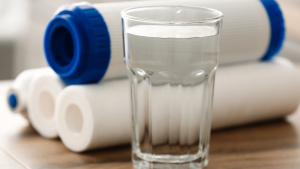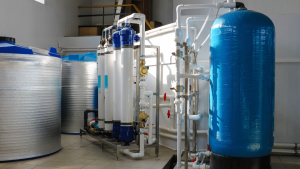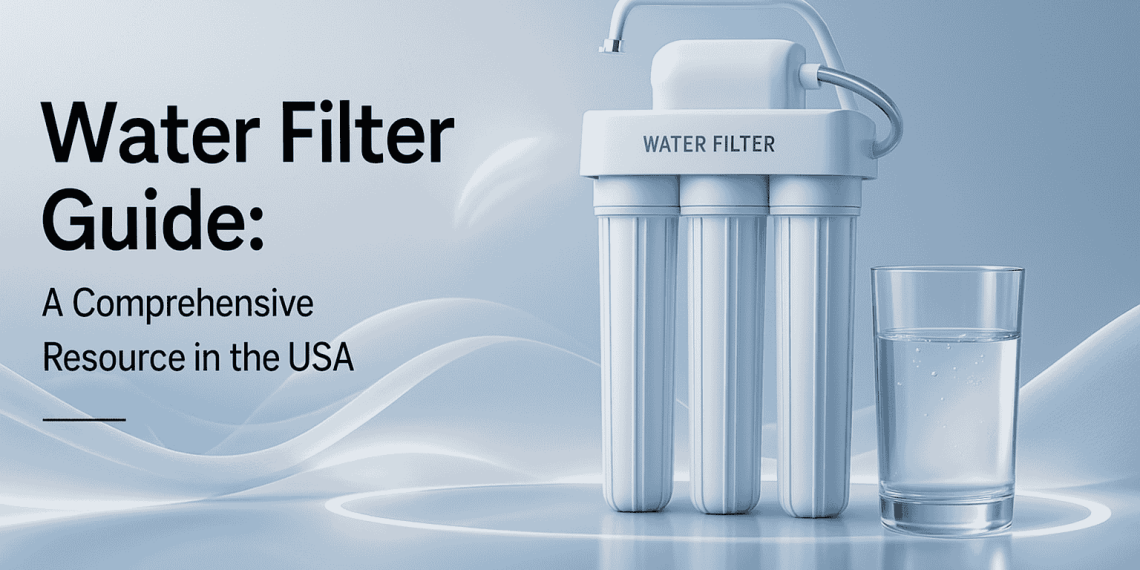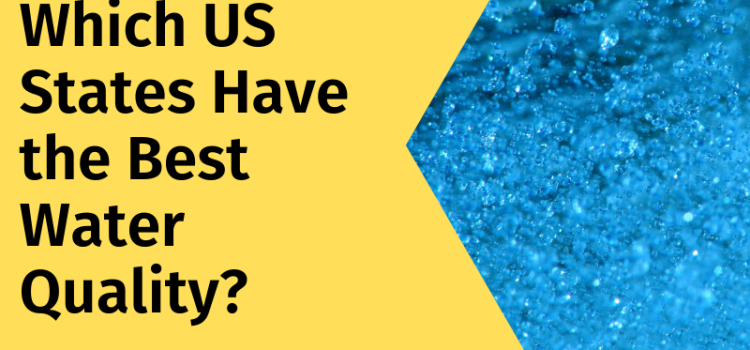Last updated on December 4th, 2025 at 01:53 pm
Home water filtration can help cut down on impurities that water utilities don’t remove. Additionally, it can aid in lowering pollutants from the water distribution system, such lead, and from water utility treatment, including disinfection byproducts.
Reverse osmosis and carbon filtration are the two main methods used in the majority of water filter devices on the market, either alone or in combination.
Most Common Filter Technologies
Carbon-based Technology
Activated carbon is used in most commercial carbon filters. As water passes through the filter, impurities are captured and eliminated. These filters are made of high-carbon materials that have been heated to form a porous structure, such as wood or coconut shells.
These filters’ levels of efficacy can differ greatly.
Some are solely certified to improve taste and odour by lowering chlorine levels in water treatment. Others can lower the concentrations of pollutants such volatile organic compounds, or VOCs, disinfection byproducts, and lead.
Certain pollutants, such nitrate, perchlorate, and 1,4 dioxane, are harder for activated carbon filters to remove.

Granulated activated carbon or carbon block are the two most common forms of carbon filters.
Activated carbon used in carbon block filters is compressed to form dense blocks. Although they are typically more costly than granular activated carbon, they are typically better at eliminating a wider variety of pollutants. This is due to their slower rate of filtration and larger surface area that comes into touch with water. However, they might require more frequent replacements.
Fine, loose grains of activated carbon are found in granulated activated carbon filters. Because water passes through them more quickly than through carbon block filters, they are typically a little less effective.
Reverse osmosis Technology
In order to decrease or eliminate a wide variety of impurities, reverse osmosis systems that are supplied for residential use usually additionally come with one or more activated carbon and sediment filters.
Trihalomethanes, VOCs, and chlorine are captured and eliminated during the first activated carbon treatment.
Tap water is then forced under pressure through a semipermeable membrane during reverse osmosis filtration, which filters out any impurities or particles bigger than water molecules. Consequently, a variety of pollutants, including arsenic, hexavalent chromium, nitrates, and perchlorate, are successfully eliminated by reverse osmosis systems.

The amount of water that reverse osmosis systems waste is their main disadvantage. These systems use three to five times as much water as they generate, with the excess water going down the drain.
Additionally, minerals like iron, calcium, and magnesium that enhance water’s flavour and are vital for good health are eliminated by reverse osmosis filters. Reverse osmosis system manufacturers may provide solutions to this issue, such as mineral drops that customers can reintroduce into their water.
Some more other kinds of filters commonly used
Ion exchange and water softeners Filters
Typically, water softeners employ an ion exchange process to lower levels of barium and radium, which are present in treated tap water, as well as calcium and magnesium, which can accumulate in pipes and fixtures. Other pollutants typically don’t alter in level.
Doctors may recommend avoiding softened water for those with specific medical issues, such as those who want to follow a low-sodium diet, because water softeners substitute sodium for calcium and magnesium.
Because salty water can damage plants, this kind of filtered water is also not advised for watering gardens and plants.
Distillation Filters
Home distillation systems are not as widespread as other forms of water purifiers. This method warms water till it vaporises, then condenses the steam back into water.
The method eliminates minerals, germs, viruses, and some compounds with a higher boiling point than water. However, it may only partially remove chlorine, trihalomethanes, or volatile organic compounds.
Whole house filters
To ensure that all taps and appliances use filtered water, whole house filters are placed where water enters a home. These systems may make use of reverse osmosis, activated carbon, or ion exchange technology.
In most situations, this kind of technology is not required and is more costly than point-of-use filtering. For instance, if the water includes high levels of iron or radiologicals that could harm household appliances, a whole system might be required.
Whole home systems may increase the risk of dangerous bacterial development in plumbing since they have the ability to eliminate chlorine.
Water is wasted a lot by whole home reverse osmosis filtering systems.










Гелиевые шарики — замечательное решение для оформления праздника. Они добавляют радости и веселья, создавая уникальную атмосферу.
[url=https://shariki-s-geliem.ru/]Шарики с гелием купить[/url] для вашего праздника!
Гелиевые шарики могут быть различных форм, размеров и цветов. Выбор включает как простые однотонные шарики, так и яркие с рисунками, что позволяет легко адаптировать их под ваше событие.
Шарики с гелием доступны как в офлайн-магазинах, так и в интернет-магазинах. Заказ через интернет может быть намного удобнее и быстрее.
Важно учитывать меры безопасности при работе с гелиевым наполнителем. Важно следить, чтобы шарики не могли попасть в воду и были под постоянным присмотром.
Every day brings new ideas and interesting topics for discussion. It is especially pleasant to share thoughts when comfort is not an empty phrase. [url=https://dlya-tebya-i-dlya-menya.by/gde-kupit-kreslo/][color=#1C1C1C] High-quality chair with delivery [/color][/url] will help make your stay at the forum even more comfortable.
Ukrainian President Volodymyr Zelensky will meet US President Joe Biden and Vice President Kamala Harris in Washington on Thursday. Leon Neal/Getty Images
CNN
—
Ukrainian President Volodymyr Zelensky’s visit to the White House on Thursday could be his final chance to convince a receptive American president of his country’s war aims.
[url=https://megaweb-14at.com]megaweb9.com[/url]
The precise details of the “victory plan” Zelensky plans to present in separate meetings to President Joe Biden and Vice President Kamala Harris are unknown, having been closely held until they are presented to the American leaders.
But according to people briefed on its broad contours, the plan reflects the Ukrainian leader’s urgent appeals for more immediate help countering Russia’s invasion. Zelensky is also poised to push for long-term security guarantees that could withstand changes in American leadership ahead of what is widely expected to be a close presidential election between Harris and former President Donald Trump.
The plan, people familiar with it said, acts as Zelensky’s response to growing war weariness even among his staunchest of western allies. It will make the case that Ukraine can still win — and does not need to cede Russian-seized territory for the fighting to end — if enough assistance is rushed in.
That includes again asking permission to fire Western provided long-range weapons deeper into Russian territory, a line Biden once was loathe to cross but which he’s recently appeared more open to as he has come under growing pressure to relent.
Even if Biden decides to allow the long-range fires, it’s unclear whether the change in policy would be announced publicly.
Biden is usually apt to take his time making decisions about providing Ukraine new capabilities. But with November’s election potentially portending a major change in American approach to the war if Trump were to win, Ukrainian officials — and many American ones — believe there is little time to waste.
megaweb5.com
https://mega555megawebat.com
Trump has claimed he will be able to “settle” the war upon taking office and has suggested he’ll end US support for Kyiv’s war effort.
“Those cities are gone, they’re gone, and we continue to give billions of dollars to a man who refused to make a deal, Zelensky. There was no deal that he could have made that wouldn’t have been better than the situation you have right now. You have a country that has been obliterated, not possible to be rebuilt,” Trump said during a campaign speech in Mint Hill, North Carolina, on Wednesday.
Comments like those have lent new weight to Thursday’s Oval Office talks, according to American and European officials, who have described an imperative to surge assistance to Ukraine while Biden is still in office.
As part of Zelensky’s visit, the US is expected to announce a major new security package, thought it will likely delay the shipping of the equipment due to inventory shortages, CNN previously reported according to two US officials. On Wednesday, the US announced a package of $375 million.
The president previewed Zelensky’s visit to the White House a day beforehand, declaring on the margins of the United Nations General Assembly his administration was “determined to ensure that Ukraine has what it needs to prevail in fight for survival.”
[url=https://megaweb-20at.com]megaweb6.com[/url]
“Tomorrow, I will announce a series of actions to accelerate support for Ukraine’s military – but we know Ukraine’s future victory is about more than what happens on the battlefield, it’s also about what Ukrainians do make the most of a free and independent future, which so many have sacrificed so much for,” he said.
[url=https://www.developgoodhabits.com/contact/?unapproved=243305&moderation-hash=7e6b247f14f70b41cf70968c2b7ede0a#comment-243305]https://www.developgoodhabits.com/contact/?unapproved=243305&moderation-hash=7e6b247f14f70b41cf70968c2b7ede0a#comment-243305[/url]
[url=https://mianswer.com/74/what-carbon-graphite-insulation-boards-rigid-graphite-felts?show=93#a93]https://mianswer.com/74/what-carbon-graphite-insulation-boards-rigid-graphite-felts?show=93#a93[/url]
[url=https://www.forum-joyingauto.com/showthread.php?tid=207135]https://www.forum-joyingauto.com/showthread.php?tid=207135[/url]
[url=https://filmmusicreporter.com/2025/08/29/mark-mothersbaugh-to-score-pixars-hoppers/?unapproved=1631533&moderation-hash=c66549d5911acaac30b03faa31fa5e31#comment-1631533]https://filmmusicreporter.com/2025/08/29/mark-mothersbaugh-to-score-pixars-hoppers/?unapproved=1631533&moderation-hash=c66549d5911acaac30b03faa31fa5e31#comment-1631533[/url]
[url=http://tsolus.com/bbs/board.php?bo_table=online&wr_id=3108299]http://tsolus.com/bbs/board.php?bo_table=online&wr_id=3108299[/url]
[url=https://www.securemac.com/support/index.php?pg=request.check&id=117115YlPhilGAyMVUOIlyaGLr]https://www.securemac.com/support/index.php?pg=request.check&id=117115YlPhilGAyMVUOIlyaGLr[/url]
[url=http://levitelecoms.com/%d0%bb%d1%83%d1%87%d1%88%d0%b8%d0%b5-%d0%be%d0%bd%d0%bb%d0%b0%d0%b9%d0%bd-%d0%ba%d0%b0%d0%b7%d0%b8%d0%bd%d0%be-%d1%81-%d0%b2%d1%8b%d1%81%d0%be%d0%ba%d0%b8%d0%bc%d0%b8-%d1%81%d1%82%d0%b0%d0%b2%d0%ba/?unapproved=45809&moderation-hash=105d9a4b55d7e6a606931f4ecf80fac8#comment-45809]http://levitelecoms.com/%d0%bb%d1%83%d1%87%d1%88%d0%b8%d0%b5-%d0%be%d0%bd%d0%bb%d0%b0%d0%b9%d0%bd-%d0%ba%d0%b0%d0%b7%d0%b8%d0%bd%d0%be-%d1%81-%d0%b2%d1%8b%d1%81%d0%be%d0%ba%d0%b8%d0%bc%d0%b8-%d1%81%d1%82%d0%b0%d0%b2%d0%ba/?unapproved=45809&moderation-hash=105d9a4b55d7e6a606931f4ecf80fac8#comment-45809[/url]
[url=https://www.giftcampaign.es/blog/guia-tecnicas-marcaje-merchandising/?unapproved=52393&moderation-hash=9f3e3cf1039e1abf626990a2546a1476#comment-52393]https://www.giftcampaign.es/blog/guia-tecnicas-marcaje-merchandising/?unapproved=52393&moderation-hash=9f3e3cf1039e1abf626990a2546a1476#comment-52393[/url]
[url=https://www.web-books.com/topic/unique-housewares/]https://www.web-books.com/topic/unique-housewares/[/url]
[url=https://hardcoredumper.com/showthread.php?tid=138068]https://hardcoredumper.com/showthread.php?tid=138068[/url]
[url=https://www.swapmotolive.com/discussing-the-jorge-prado-tom-vialle-drama-inside-sml-ep-84/videos-theater/inside-sml/#comment-67514]https://www.swapmotolive.com/discussing-the-jorge-prado-tom-vialle-drama-inside-sml-ep-84/videos-theater/inside-sml/#comment-67514[/url]
[url=https://www.econjobrumors.com/topic/unique-housewares?replies=1#post-10773667]https://www.econjobrumors.com/topic/unique-housewares?replies=1#post-10773667[/url]
[url=https://andangfoundation.org/bbs/board.php?bo_table=qa&wr_id=522273]https://andangfoundation.org/bbs/board.php?bo_table=qa&wr_id=522273[/url]
[url=http://hydrochem-e.com/bbs/board.php?bo_table=online&wr_id=725744]http://hydrochem-e.com/bbs/board.php?bo_table=online&wr_id=725744[/url]
[url=http://mchelp.xyz/index.php/4517/the-foolproof-coffee-message-board-strategy?show=142880#a142880]http://mchelp.xyz/index.php/4517/the-foolproof-coffee-message-board-strategy?show=142880#a142880[/url]
[url=https://fangirlish.com/?contact-form-id=widget-block-9-blog&contact-form-sent=647379&contact-form-hash=196bca9cc37ca7d3136fa38998dc7b9da67a68cb&_wpnonce=d2fef32a0e]https://fangirlish.com/?contact-form-id=widget-block-9-blog&contact-form-sent=647379&contact-form-hash=196bca9cc37ca7d3136fa38998dc7b9da67a68cb&_wpnonce=d2fef32a0e[/url]
[url=https://fangirlish.com/?contact-form-id=widget-block-9-blog&contact-form-sent=647379&contact-form-hash=196bca9cc37ca7d3136fa38998dc7b9da67a68cb&_wpnonce=d2fef32a0e]https://fangirlish.com/?contact-form-id=widget-block-9-blog&contact-form-sent=647379&contact-form-hash=196bca9cc37ca7d3136fa38998dc7b9da67a68cb&_wpnonce=d2fef32a0e[/url]
[url=https://mens30slife.com/fukuoka/?unapproved=568203&moderation-hash=af626aa06d494da17070bea83e1e6c0f#comment-568203]https://mens30slife.com/fukuoka/?unapproved=568203&moderation-hash=af626aa06d494da17070bea83e1e6c0f#comment-568203[/url]
[url=https://disinformazione.it/2025/08/28/villaggio-bitcoin/#comment-77]https://disinformazione.it/2025/08/28/villaggio-bitcoin/#comment-77[/url]
[url=https://www.mindbrowse.com/2019/12/05/welcome-to-mindbrowse-com/?unapproved=406776&moderation-hash=b3fa593ea4a1942df9a92d3701da7c93#comment-406776]https://www.mindbrowse.com/2019/12/05/welcome-to-mindbrowse-com/?unapproved=406776&moderation-hash=b3fa593ea4a1942df9a92d3701da7c93#comment-406776[/url]
[url=https://magcaldi.vn/?unapproved=816001&moderation-hash=d945fab9fb5b4c5b38e93ea6bc271284#comment-816001]https://magcaldi.vn/?unapproved=816001&moderation-hash=d945fab9fb5b4c5b38e93ea6bc271284#comment-816001[/url]
[url=http://bananon.com/bananon-papayina/?unapproved=254224&moderation-hash=b9d8bcbedc2dac00497a41e70f670052#comment-254224]http://bananon.com/bananon-papayina/?unapproved=254224&moderation-hash=b9d8bcbedc2dac00497a41e70f670052#comment-254224[/url]
[url=http://interlifedesigns.net/sas/announcing-our-brand-new-turquoise-series/?unapproved=173296&moderation-hash=bb2f5ebb96633e177e771f7bd22a8292#comment-173296]http://interlifedesigns.net/sas/announcing-our-brand-new-turquoise-series/?unapproved=173296&moderation-hash=bb2f5ebb96633e177e771f7bd22a8292#comment-173296[/url]
[url=https://eletric-vehicles.com/contact-2/?contact-form-id=14298&contact-form-sent=83138&contact-form-hash=d16e530076467c4f89fb699cd747ebad7fa2c3fd&_wpnonce=b6e261268a]https://eletric-vehicles.com/contact-2/?contact-form-id=14298&contact-form-sent=83138&contact-form-hash=d16e530076467c4f89fb699cd747ebad7fa2c3fd&_wpnonce=b6e261268a[/url]
[url=https://eletric-vehicles.com/contact-2/?contact-form-id=14298&contact-form-sent=83138&contact-form-hash=d16e530076467c4f89fb699cd747ebad7fa2c3fd&_wpnonce=b6e261268a]https://eletric-vehicles.com/contact-2/?contact-form-id=14298&contact-form-sent=83138&contact-form-hash=d16e530076467c4f89fb699cd747ebad7fa2c3fd&_wpnonce=b6e261268a[/url]
[url=https://datxanhvn.vn/khu-dan-cu-thuong-mai-va-cho-vuc-lightland-hai-tien/?unapproved=29982&moderation-hash=19cd1c804766c4fb434360356264a619#comment-29982]https://datxanhvn.vn/khu-dan-cu-thuong-mai-va-cho-vuc-lightland-hai-tien/?unapproved=29982&moderation-hash=19cd1c804766c4fb434360356264a619#comment-29982[/url]
[url=https://rankingroyals.com/contact/?contact-form-id=70-1&contact-form-sent=12459&contact-form-hash=87338cc6cf9107be2ecfe79b83eabbc379f63eef&_wpnonce=3a0d42705e]https://rankingroyals.com/contact/?contact-form-id=70-1&contact-form-sent=12459&contact-form-hash=87338cc6cf9107be2ecfe79b83eabbc379f63eef&_wpnonce=3a0d42705e[/url]
[url=https://rankingroyals.com/contact/?contact-form-id=70-1&contact-form-sent=12459&contact-form-hash=87338cc6cf9107be2ecfe79b83eabbc379f63eef&_wpnonce=3a0d42705e]https://rankingroyals.com/contact/?contact-form-id=70-1&contact-form-sent=12459&contact-form-hash=87338cc6cf9107be2ecfe79b83eabbc379f63eef&_wpnonce=3a0d42705e[/url]
[url=https://www.gastronomeet.com/2019/08/28/discover-sommelier-maximes-wine-secrets/?unapproved=581424&moderation-hash=adb6cabde99a21db0d932ba6f9652518#comment-581424]https://www.gastronomeet.com/2019/08/28/discover-sommelier-maximes-wine-secrets/?unapproved=581424&moderation-hash=adb6cabde99a21db0d932ba6f9652518#comment-581424[/url]
[url=https://www.mindik.com/seksi-minyon-kiz-dusta-buyuk-yaraga-talim-oluyor/?unapproved=324563&moderation-hash=5056d3e9ad96d8ed4978c73e705a183f#comment-324563]https://www.mindik.com/seksi-minyon-kiz-dusta-buyuk-yaraga-talim-oluyor/?unapproved=324563&moderation-hash=5056d3e9ad96d8ed4978c73e705a183f#comment-324563[/url]
[url=https://puertasautomaticasmena.es/profesionales-especializados/?unapproved=321823&moderation-hash=b723a3a49ccc302bd7a9a6a020995bb1#comment-321823]https://puertasautomaticasmena.es/profesionales-especializados/?unapproved=321823&moderation-hash=b723a3a49ccc302bd7a9a6a020995bb1#comment-321823[/url]
[url=https://woldcnews.com/contact/?contact-form-id=1654065&contact-form-sent=3548869&contact-form-hash=8684a5b4868b7796f6d4c8202b7f8182b789c700&_wpnonce=8b15dadbc3]https://woldcnews.com/contact/?contact-form-id=1654065&contact-form-sent=3548869&contact-form-hash=8684a5b4868b7796f6d4c8202b7f8182b789c700&_wpnonce=8b15dadbc3[/url]
[url=https://woldcnews.com/contact/?contact-form-id=1654065&contact-form-sent=3548869&contact-form-hash=8684a5b4868b7796f6d4c8202b7f8182b789c700&_wpnonce=8b15dadbc3]https://woldcnews.com/contact/?contact-form-id=1654065&contact-form-sent=3548869&contact-form-hash=8684a5b4868b7796f6d4c8202b7f8182b789c700&_wpnonce=8b15dadbc3[/url]
[url=https://richsikra.com/?p=527&unapproved=110443&moderation-hash=9b536cad05e77e8fbdfa35df5ae67f87#comment-110443]https://richsikra.com/?p=527&unapproved=110443&moderation-hash=9b536cad05e77e8fbdfa35df5ae67f87#comment-110443[/url]
[url=http://netdni.com/huong-dan-root-mazda-connect/?unapproved=323424&moderation-hash=13d8d4cb04ce770339a3ffccf0e354d9#comment-323424]http://netdni.com/huong-dan-root-mazda-connect/?unapproved=323424&moderation-hash=13d8d4cb04ce770339a3ffccf0e354d9#comment-323424[/url]
[url=https://www.adoveinthebelljar.com/contact?unapproved=262088&moderation-hash=d8f0a5742256c28e5c3097be4c149a4f#comment-262088]https://www.adoveinthebelljar.com/contact?unapproved=262088&moderation-hash=d8f0a5742256c28e5c3097be4c149a4f#comment-262088[/url]
[url=https://dcaerials.org/?unapproved=413343&moderation-hash=f462f501b887627e5d1290e7c388dbcd#comment-413343]https://dcaerials.org/?unapproved=413343&moderation-hash=f462f501b887627e5d1290e7c388dbcd#comment-413343[/url]
[url=https://1xbetsport-uz.com/?unapproved=234454&moderation-hash=0ea14e60bb1323903c5c5345eba8b834]https://1xbetsport-uz.com/?unapproved=234454&moderation-hash=0ea14e60bb1323903c5c5345eba8b834[/url]
[url=https://www.japangoodsfinder.com/grounds-sneakers/?unapproved=49846&moderation-hash=952702f1e1fcb3aef8bbe5a525489d59#comment-49846]https://www.japangoodsfinder.com/grounds-sneakers/?unapproved=49846&moderation-hash=952702f1e1fcb3aef8bbe5a525489d59#comment-49846[/url]
[url=https://aviator-mocambique.co.mz/?unapproved=1901&moderation-hash=d6d3cda961bbde2c201d329bf11a2938#comment-1901]https://aviator-mocambique.co.mz/?unapproved=1901&moderation-hash=d6d3cda961bbde2c201d329bf11a2938#comment-1901[/url]
[url=https://www.developgoodhabits.com/contact/?unapproved=243305&moderation-hash=7e6b247f14f70b41cf70968c2b7ede0a#comment-243305]https://www.developgoodhabits.com/contact/?unapproved=243305&moderation-hash=7e6b247f14f70b41cf70968c2b7ede0a#comment-243305[/url]
[url=https://mianswer.com/74/what-carbon-graphite-insulation-boards-rigid-graphite-felts?show=93#a93]https://mianswer.com/74/what-carbon-graphite-insulation-boards-rigid-graphite-felts?show=93#a93[/url]
[url=https://www.forum-joyingauto.com/showthread.php?tid=207135]https://www.forum-joyingauto.com/showthread.php?tid=207135[/url]
[url=https://filmmusicreporter.com/2025/08/29/mark-mothersbaugh-to-score-pixars-hoppers/?unapproved=1631533&moderation-hash=c66549d5911acaac30b03faa31fa5e31#comment-1631533]https://filmmusicreporter.com/2025/08/29/mark-mothersbaugh-to-score-pixars-hoppers/?unapproved=1631533&moderation-hash=c66549d5911acaac30b03faa31fa5e31#comment-1631533[/url]
[url=http://tsolus.com/bbs/board.php?bo_table=online&wr_id=3108299]http://tsolus.com/bbs/board.php?bo_table=online&wr_id=3108299[/url]
[url=https://www.securemac.com/support/index.php?pg=request.check&id=117115YlPhilGAyMVUOIlyaGLr]https://www.securemac.com/support/index.php?pg=request.check&id=117115YlPhilGAyMVUOIlyaGLr[/url]
[url=https://www.giftcampaign.es/blog/guia-tecnicas-marcaje-merchandising/?unapproved=52393&moderation-hash=9f3e3cf1039e1abf626990a2546a1476#comment-52393]https://www.giftcampaign.es/blog/guia-tecnicas-marcaje-merchandising/?unapproved=52393&moderation-hash=9f3e3cf1039e1abf626990a2546a1476#comment-52393[/url]
[url=http://levitelecoms.com/%d0%bb%d1%83%d1%87%d1%88%d0%b8%d0%b5-%d0%be%d0%bd%d0%bb%d0%b0%d0%b9%d0%bd-%d0%ba%d0%b0%d0%b7%d0%b8%d0%bd%d0%be-%d1%81-%d0%b2%d1%8b%d1%81%d0%be%d0%ba%d0%b8%d0%bc%d0%b8-%d1%81%d1%82%d0%b0%d0%b2%d0%ba/?unapproved=45809&moderation-hash=105d9a4b55d7e6a606931f4ecf80fac8#comment-45809]http://levitelecoms.com/%d0%bb%d1%83%d1%87%d1%88%d0%b8%d0%b5-%d0%be%d0%bd%d0%bb%d0%b0%d0%b9%d0%bd-%d0%ba%d0%b0%d0%b7%d0%b8%d0%bd%d0%be-%d1%81-%d0%b2%d1%8b%d1%81%d0%be%d0%ba%d0%b8%d0%bc%d0%b8-%d1%81%d1%82%d0%b0%d0%b2%d0%ba/?unapproved=45809&moderation-hash=105d9a4b55d7e6a606931f4ecf80fac8#comment-45809[/url]
[url=https://www.web-books.com/topic/unique-housewares/]https://www.web-books.com/topic/unique-housewares/[/url]
[url=https://hardcoredumper.com/showthread.php?tid=138068]https://hardcoredumper.com/showthread.php?tid=138068[/url]
[url=https://www.swapmotolive.com/discussing-the-jorge-prado-tom-vialle-drama-inside-sml-ep-84/videos-theater/inside-sml/#comment-67514]https://www.swapmotolive.com/discussing-the-jorge-prado-tom-vialle-drama-inside-sml-ep-84/videos-theater/inside-sml/#comment-67514[/url]
[url=https://www.econjobrumors.com/topic/unique-housewares?replies=1#post-10773667]https://www.econjobrumors.com/topic/unique-housewares?replies=1#post-10773667[/url]
[url=http://hydrochem-e.com/bbs/board.php?bo_table=online&wr_id=725744]http://hydrochem-e.com/bbs/board.php?bo_table=online&wr_id=725744[/url]
[url=https://andangfoundation.org/bbs/board.php?bo_table=qa&wr_id=522273]https://andangfoundation.org/bbs/board.php?bo_table=qa&wr_id=522273[/url]
[url=https://fangirlish.com/?contact-form-id=widget-block-9-blog&contact-form-sent=647379&contact-form-hash=196bca9cc37ca7d3136fa38998dc7b9da67a68cb&_wpnonce=d2fef32a0e]https://fangirlish.com/?contact-form-id=widget-block-9-blog&contact-form-sent=647379&contact-form-hash=196bca9cc37ca7d3136fa38998dc7b9da67a68cb&_wpnonce=d2fef32a0e[/url]
[url=https://fangirlish.com/?contact-form-id=widget-block-9-blog&contact-form-sent=647379&contact-form-hash=196bca9cc37ca7d3136fa38998dc7b9da67a68cb&_wpnonce=d2fef32a0e]https://fangirlish.com/?contact-form-id=widget-block-9-blog&contact-form-sent=647379&contact-form-hash=196bca9cc37ca7d3136fa38998dc7b9da67a68cb&_wpnonce=d2fef32a0e[/url]
[url=http://mchelp.xyz/index.php/4517/the-foolproof-coffee-message-board-strategy?show=142880#a142880]http://mchelp.xyz/index.php/4517/the-foolproof-coffee-message-board-strategy?show=142880#a142880[/url]
[url=https://mens30slife.com/fukuoka/?unapproved=568203&moderation-hash=af626aa06d494da17070bea83e1e6c0f#comment-568203]https://mens30slife.com/fukuoka/?unapproved=568203&moderation-hash=af626aa06d494da17070bea83e1e6c0f#comment-568203[/url]
[url=https://disinformazione.it/2025/08/28/villaggio-bitcoin/#comment-77]https://disinformazione.it/2025/08/28/villaggio-bitcoin/#comment-77[/url]
[url=https://www.mindbrowse.com/2019/12/05/welcome-to-mindbrowse-com/?unapproved=406776&moderation-hash=b3fa593ea4a1942df9a92d3701da7c93#comment-406776]https://www.mindbrowse.com/2019/12/05/welcome-to-mindbrowse-com/?unapproved=406776&moderation-hash=b3fa593ea4a1942df9a92d3701da7c93#comment-406776[/url]
[url=https://magcaldi.vn/?unapproved=816001&moderation-hash=d945fab9fb5b4c5b38e93ea6bc271284#comment-816001]https://magcaldi.vn/?unapproved=816001&moderation-hash=d945fab9fb5b4c5b38e93ea6bc271284#comment-816001[/url]
[url=http://bananon.com/bananon-papayina/?unapproved=254224&moderation-hash=b9d8bcbedc2dac00497a41e70f670052#comment-254224]http://bananon.com/bananon-papayina/?unapproved=254224&moderation-hash=b9d8bcbedc2dac00497a41e70f670052#comment-254224[/url]
[url=http://interlifedesigns.net/sas/announcing-our-brand-new-turquoise-series/?unapproved=173296&moderation-hash=bb2f5ebb96633e177e771f7bd22a8292#comment-173296]http://interlifedesigns.net/sas/announcing-our-brand-new-turquoise-series/?unapproved=173296&moderation-hash=bb2f5ebb96633e177e771f7bd22a8292#comment-173296[/url]
[url=https://eletric-vehicles.com/contact-2/?contact-form-id=14298&contact-form-sent=83138&contact-form-hash=d16e530076467c4f89fb699cd747ebad7fa2c3fd&_wpnonce=b6e261268a]https://eletric-vehicles.com/contact-2/?contact-form-id=14298&contact-form-sent=83138&contact-form-hash=d16e530076467c4f89fb699cd747ebad7fa2c3fd&_wpnonce=b6e261268a[/url]
[url=https://eletric-vehicles.com/contact-2/?contact-form-id=14298&contact-form-sent=83138&contact-form-hash=d16e530076467c4f89fb699cd747ebad7fa2c3fd&_wpnonce=b6e261268a]https://eletric-vehicles.com/contact-2/?contact-form-id=14298&contact-form-sent=83138&contact-form-hash=d16e530076467c4f89fb699cd747ebad7fa2c3fd&_wpnonce=b6e261268a[/url]
[url=https://datxanhvn.vn/khu-dan-cu-thuong-mai-va-cho-vuc-lightland-hai-tien/?unapproved=29982&moderation-hash=19cd1c804766c4fb434360356264a619#comment-29982]https://datxanhvn.vn/khu-dan-cu-thuong-mai-va-cho-vuc-lightland-hai-tien/?unapproved=29982&moderation-hash=19cd1c804766c4fb434360356264a619#comment-29982[/url]
[url=https://rankingroyals.com/contact/?contact-form-id=70-1&contact-form-sent=12459&contact-form-hash=87338cc6cf9107be2ecfe79b83eabbc379f63eef&_wpnonce=3a0d42705e]https://rankingroyals.com/contact/?contact-form-id=70-1&contact-form-sent=12459&contact-form-hash=87338cc6cf9107be2ecfe79b83eabbc379f63eef&_wpnonce=3a0d42705e[/url]
[url=https://rankingroyals.com/contact/?contact-form-id=70-1&contact-form-sent=12459&contact-form-hash=87338cc6cf9107be2ecfe79b83eabbc379f63eef&_wpnonce=3a0d42705e]https://rankingroyals.com/contact/?contact-form-id=70-1&contact-form-sent=12459&contact-form-hash=87338cc6cf9107be2ecfe79b83eabbc379f63eef&_wpnonce=3a0d42705e[/url]
[url=https://www.gastronomeet.com/2019/08/28/discover-sommelier-maximes-wine-secrets/?unapproved=581424&moderation-hash=adb6cabde99a21db0d932ba6f9652518#comment-581424]https://www.gastronomeet.com/2019/08/28/discover-sommelier-maximes-wine-secrets/?unapproved=581424&moderation-hash=adb6cabde99a21db0d932ba6f9652518#comment-581424[/url]
[url=https://puertasautomaticasmena.es/profesionales-especializados/?unapproved=321823&moderation-hash=b723a3a49ccc302bd7a9a6a020995bb1#comment-321823]https://puertasautomaticasmena.es/profesionales-especializados/?unapproved=321823&moderation-hash=b723a3a49ccc302bd7a9a6a020995bb1#comment-321823[/url]
[url=https://www.mindik.com/seksi-minyon-kiz-dusta-buyuk-yaraga-talim-oluyor/?unapproved=324563&moderation-hash=5056d3e9ad96d8ed4978c73e705a183f#comment-324563]https://www.mindik.com/seksi-minyon-kiz-dusta-buyuk-yaraga-talim-oluyor/?unapproved=324563&moderation-hash=5056d3e9ad96d8ed4978c73e705a183f#comment-324563[/url]
[url=https://dcaerials.org/?unapproved=413343&moderation-hash=f462f501b887627e5d1290e7c388dbcd#comment-413343]https://dcaerials.org/?unapproved=413343&moderation-hash=f462f501b887627e5d1290e7c388dbcd#comment-413343[/url]
[url=https://woldcnews.com/contact/?contact-form-id=1654065&contact-form-sent=3548869&contact-form-hash=8684a5b4868b7796f6d4c8202b7f8182b789c700&_wpnonce=8b15dadbc3]https://woldcnews.com/contact/?contact-form-id=1654065&contact-form-sent=3548869&contact-form-hash=8684a5b4868b7796f6d4c8202b7f8182b789c700&_wpnonce=8b15dadbc3[/url]
[url=https://woldcnews.com/contact/?contact-form-id=1654065&contact-form-sent=3548869&contact-form-hash=8684a5b4868b7796f6d4c8202b7f8182b789c700&_wpnonce=8b15dadbc3]https://woldcnews.com/contact/?contact-form-id=1654065&contact-form-sent=3548869&contact-form-hash=8684a5b4868b7796f6d4c8202b7f8182b789c700&_wpnonce=8b15dadbc3[/url]
[url=http://netdni.com/huong-dan-root-mazda-connect/?unapproved=323424&moderation-hash=13d8d4cb04ce770339a3ffccf0e354d9#comment-323424]http://netdni.com/huong-dan-root-mazda-connect/?unapproved=323424&moderation-hash=13d8d4cb04ce770339a3ffccf0e354d9#comment-323424[/url]
[url=https://www.adoveinthebelljar.com/contact?unapproved=262088&moderation-hash=d8f0a5742256c28e5c3097be4c149a4f#comment-262088]https://www.adoveinthebelljar.com/contact?unapproved=262088&moderation-hash=d8f0a5742256c28e5c3097be4c149a4f#comment-262088[/url]
[url=https://richsikra.com/?p=527&unapproved=110443&moderation-hash=9b536cad05e77e8fbdfa35df5ae67f87#comment-110443]https://richsikra.com/?p=527&unapproved=110443&moderation-hash=9b536cad05e77e8fbdfa35df5ae67f87#comment-110443[/url]
[url=https://1xbetsport-uz.com/?unapproved=234454&moderation-hash=0ea14e60bb1323903c5c5345eba8b834]https://1xbetsport-uz.com/?unapproved=234454&moderation-hash=0ea14e60bb1323903c5c5345eba8b834[/url]
[url=https://mostbet-kz.org/?unapproved=23377&moderation-hash=594d78c379c5d27f9af213a9c6cf5125#comment-23377]https://mostbet-kz.org/?unapproved=23377&moderation-hash=594d78c379c5d27f9af213a9c6cf5125#comment-23377[/url]
[url=https://www.hatayisrehberi.com/serinyol-escort/?unapproved=148207&moderation-hash=be9666140376f73344e64a42891c2418#comment-148207]https://www.hatayisrehberi.com/serinyol-escort/?unapproved=148207&moderation-hash=be9666140376f73344e64a42891c2418#comment-148207[/url]
[url=https://www.bestfive.com.au/best-apps-for-kids/?unapproved=21088&moderation-hash=1903cc6ffd69db58e861f29b90f37a2d#comment-21088]https://www.bestfive.com.au/best-apps-for-kids/?unapproved=21088&moderation-hash=1903cc6ffd69db58e861f29b90f37a2d#comment-21088[/url]
[url=https://aviator-games.mw/?unapproved=2360&moderation-hash=0c4bce89610dd9f1b7a8fa95771780cd#comment-2360]https://aviator-games.mw/?unapproved=2360&moderation-hash=0c4bce89610dd9f1b7a8fa95771780cd#comment-2360[/url]
[url=https://www.developgoodhabits.com/contact/?unapproved=243305&moderation-hash=7e6b247f14f70b41cf70968c2b7ede0a#comment-243305]https://www.developgoodhabits.com/contact/?unapproved=243305&moderation-hash=7e6b247f14f70b41cf70968c2b7ede0a#comment-243305[/url]
[url=https://mianswer.com/74/what-carbon-graphite-insulation-boards-rigid-graphite-felts?show=93#a93]https://mianswer.com/74/what-carbon-graphite-insulation-boards-rigid-graphite-felts?show=93#a93[/url]
[url=https://www.forum-joyingauto.com/showthread.php?tid=207135]https://www.forum-joyingauto.com/showthread.php?tid=207135[/url]
[url=https://filmmusicreporter.com/2025/08/29/mark-mothersbaugh-to-score-pixars-hoppers/?unapproved=1631533&moderation-hash=c66549d5911acaac30b03faa31fa5e31#comment-1631533]https://filmmusicreporter.com/2025/08/29/mark-mothersbaugh-to-score-pixars-hoppers/?unapproved=1631533&moderation-hash=c66549d5911acaac30b03faa31fa5e31#comment-1631533[/url]
[url=http://tsolus.com/bbs/board.php?bo_table=online&wr_id=3108299]http://tsolus.com/bbs/board.php?bo_table=online&wr_id=3108299[/url]
[url=https://www.securemac.com/support/index.php?pg=request.check&id=117115YlPhilGAyMVUOIlyaGLr]https://www.securemac.com/support/index.php?pg=request.check&id=117115YlPhilGAyMVUOIlyaGLr[/url]
[url=https://www.giftcampaign.es/blog/guia-tecnicas-marcaje-merchandising/?unapproved=52393&moderation-hash=9f3e3cf1039e1abf626990a2546a1476#comment-52393]https://www.giftcampaign.es/blog/guia-tecnicas-marcaje-merchandising/?unapproved=52393&moderation-hash=9f3e3cf1039e1abf626990a2546a1476#comment-52393[/url]
[url=http://levitelecoms.com/%d0%bb%d1%83%d1%87%d1%88%d0%b8%d0%b5-%d0%be%d0%bd%d0%bb%d0%b0%d0%b9%d0%bd-%d0%ba%d0%b0%d0%b7%d0%b8%d0%bd%d0%be-%d1%81-%d0%b2%d1%8b%d1%81%d0%be%d0%ba%d0%b8%d0%bc%d0%b8-%d1%81%d1%82%d0%b0%d0%b2%d0%ba/?unapproved=45809&moderation-hash=105d9a4b55d7e6a606931f4ecf80fac8#comment-45809]http://levitelecoms.com/%d0%bb%d1%83%d1%87%d1%88%d0%b8%d0%b5-%d0%be%d0%bd%d0%bb%d0%b0%d0%b9%d0%bd-%d0%ba%d0%b0%d0%b7%d0%b8%d0%bd%d0%be-%d1%81-%d0%b2%d1%8b%d1%81%d0%be%d0%ba%d0%b8%d0%bc%d0%b8-%d1%81%d1%82%d0%b0%d0%b2%d0%ba/?unapproved=45809&moderation-hash=105d9a4b55d7e6a606931f4ecf80fac8#comment-45809[/url]
[url=https://www.web-books.com/topic/unique-housewares/]https://www.web-books.com/topic/unique-housewares/[/url]
[url=https://hardcoredumper.com/showthread.php?tid=138068]https://hardcoredumper.com/showthread.php?tid=138068[/url]
[url=https://www.swapmotolive.com/discussing-the-jorge-prado-tom-vialle-drama-inside-sml-ep-84/videos-theater/inside-sml/#comment-67514]https://www.swapmotolive.com/discussing-the-jorge-prado-tom-vialle-drama-inside-sml-ep-84/videos-theater/inside-sml/#comment-67514[/url]
[url=https://www.econjobrumors.com/topic/unique-housewares?replies=1#post-10773667]https://www.econjobrumors.com/topic/unique-housewares?replies=1#post-10773667[/url]
[url=http://hydrochem-e.com/bbs/board.php?bo_table=online&wr_id=725744]http://hydrochem-e.com/bbs/board.php?bo_table=online&wr_id=725744[/url]
[url=https://andangfoundation.org/bbs/board.php?bo_table=qa&wr_id=522273]https://andangfoundation.org/bbs/board.php?bo_table=qa&wr_id=522273[/url]
[url=https://fangirlish.com/?contact-form-id=widget-block-9-blog&contact-form-sent=647379&contact-form-hash=196bca9cc37ca7d3136fa38998dc7b9da67a68cb&_wpnonce=d2fef32a0e]https://fangirlish.com/?contact-form-id=widget-block-9-blog&contact-form-sent=647379&contact-form-hash=196bca9cc37ca7d3136fa38998dc7b9da67a68cb&_wpnonce=d2fef32a0e[/url]
[url=https://fangirlish.com/?contact-form-id=widget-block-9-blog&contact-form-sent=647379&contact-form-hash=196bca9cc37ca7d3136fa38998dc7b9da67a68cb&_wpnonce=d2fef32a0e]https://fangirlish.com/?contact-form-id=widget-block-9-blog&contact-form-sent=647379&contact-form-hash=196bca9cc37ca7d3136fa38998dc7b9da67a68cb&_wpnonce=d2fef32a0e[/url]
[url=http://mchelp.xyz/index.php/4517/the-foolproof-coffee-message-board-strategy?show=142880#a142880]http://mchelp.xyz/index.php/4517/the-foolproof-coffee-message-board-strategy?show=142880#a142880[/url]
[url=https://mens30slife.com/fukuoka/?unapproved=568203&moderation-hash=af626aa06d494da17070bea83e1e6c0f#comment-568203]https://mens30slife.com/fukuoka/?unapproved=568203&moderation-hash=af626aa06d494da17070bea83e1e6c0f#comment-568203[/url]
[url=https://disinformazione.it/2025/08/28/villaggio-bitcoin/#comment-77]https://disinformazione.it/2025/08/28/villaggio-bitcoin/#comment-77[/url]
[url=https://www.mindbrowse.com/2019/12/05/welcome-to-mindbrowse-com/?unapproved=406776&moderation-hash=b3fa593ea4a1942df9a92d3701da7c93#comment-406776]https://www.mindbrowse.com/2019/12/05/welcome-to-mindbrowse-com/?unapproved=406776&moderation-hash=b3fa593ea4a1942df9a92d3701da7c93#comment-406776[/url]
[url=https://magcaldi.vn/?unapproved=816001&moderation-hash=d945fab9fb5b4c5b38e93ea6bc271284#comment-816001]https://magcaldi.vn/?unapproved=816001&moderation-hash=d945fab9fb5b4c5b38e93ea6bc271284#comment-816001[/url]
[url=http://bananon.com/bananon-papayina/?unapproved=254224&moderation-hash=b9d8bcbedc2dac00497a41e70f670052#comment-254224]http://bananon.com/bananon-papayina/?unapproved=254224&moderation-hash=b9d8bcbedc2dac00497a41e70f670052#comment-254224[/url]
[url=http://interlifedesigns.net/sas/announcing-our-brand-new-turquoise-series/?unapproved=173296&moderation-hash=bb2f5ebb96633e177e771f7bd22a8292#comment-173296]http://interlifedesigns.net/sas/announcing-our-brand-new-turquoise-series/?unapproved=173296&moderation-hash=bb2f5ebb96633e177e771f7bd22a8292#comment-173296[/url]
[url=https://eletric-vehicles.com/contact-2/?contact-form-id=14298&contact-form-sent=83138&contact-form-hash=d16e530076467c4f89fb699cd747ebad7fa2c3fd&_wpnonce=b6e261268a]https://eletric-vehicles.com/contact-2/?contact-form-id=14298&contact-form-sent=83138&contact-form-hash=d16e530076467c4f89fb699cd747ebad7fa2c3fd&_wpnonce=b6e261268a[/url]
[url=https://eletric-vehicles.com/contact-2/?contact-form-id=14298&contact-form-sent=83138&contact-form-hash=d16e530076467c4f89fb699cd747ebad7fa2c3fd&_wpnonce=b6e261268a]https://eletric-vehicles.com/contact-2/?contact-form-id=14298&contact-form-sent=83138&contact-form-hash=d16e530076467c4f89fb699cd747ebad7fa2c3fd&_wpnonce=b6e261268a[/url]
[url=https://datxanhvn.vn/khu-dan-cu-thuong-mai-va-cho-vuc-lightland-hai-tien/?unapproved=29982&moderation-hash=19cd1c804766c4fb434360356264a619#comment-29982]https://datxanhvn.vn/khu-dan-cu-thuong-mai-va-cho-vuc-lightland-hai-tien/?unapproved=29982&moderation-hash=19cd1c804766c4fb434360356264a619#comment-29982[/url]
[url=https://rankingroyals.com/contact/?contact-form-id=70-1&contact-form-sent=12459&contact-form-hash=87338cc6cf9107be2ecfe79b83eabbc379f63eef&_wpnonce=3a0d42705e]https://rankingroyals.com/contact/?contact-form-id=70-1&contact-form-sent=12459&contact-form-hash=87338cc6cf9107be2ecfe79b83eabbc379f63eef&_wpnonce=3a0d42705e[/url]
[url=https://rankingroyals.com/contact/?contact-form-id=70-1&contact-form-sent=12459&contact-form-hash=87338cc6cf9107be2ecfe79b83eabbc379f63eef&_wpnonce=3a0d42705e]https://rankingroyals.com/contact/?contact-form-id=70-1&contact-form-sent=12459&contact-form-hash=87338cc6cf9107be2ecfe79b83eabbc379f63eef&_wpnonce=3a0d42705e[/url]
[url=https://www.gastronomeet.com/2019/08/28/discover-sommelier-maximes-wine-secrets/?unapproved=581424&moderation-hash=adb6cabde99a21db0d932ba6f9652518#comment-581424]https://www.gastronomeet.com/2019/08/28/discover-sommelier-maximes-wine-secrets/?unapproved=581424&moderation-hash=adb6cabde99a21db0d932ba6f9652518#comment-581424[/url]
[url=https://puertasautomaticasmena.es/profesionales-especializados/?unapproved=321823&moderation-hash=b723a3a49ccc302bd7a9a6a020995bb1#comment-321823]https://puertasautomaticasmena.es/profesionales-especializados/?unapproved=321823&moderation-hash=b723a3a49ccc302bd7a9a6a020995bb1#comment-321823[/url]
[url=https://www.mindik.com/seksi-minyon-kiz-dusta-buyuk-yaraga-talim-oluyor/?unapproved=324563&moderation-hash=5056d3e9ad96d8ed4978c73e705a183f#comment-324563]https://www.mindik.com/seksi-minyon-kiz-dusta-buyuk-yaraga-talim-oluyor/?unapproved=324563&moderation-hash=5056d3e9ad96d8ed4978c73e705a183f#comment-324563[/url]
[url=https://dcaerials.org/?unapproved=413343&moderation-hash=f462f501b887627e5d1290e7c388dbcd#comment-413343]https://dcaerials.org/?unapproved=413343&moderation-hash=f462f501b887627e5d1290e7c388dbcd#comment-413343[/url]
[url=https://woldcnews.com/contact/?contact-form-id=1654065&contact-form-sent=3548869&contact-form-hash=8684a5b4868b7796f6d4c8202b7f8182b789c700&_wpnonce=8b15dadbc3]https://woldcnews.com/contact/?contact-form-id=1654065&contact-form-sent=3548869&contact-form-hash=8684a5b4868b7796f6d4c8202b7f8182b789c700&_wpnonce=8b15dadbc3[/url]
[url=https://woldcnews.com/contact/?contact-form-id=1654065&contact-form-sent=3548869&contact-form-hash=8684a5b4868b7796f6d4c8202b7f8182b789c700&_wpnonce=8b15dadbc3]https://woldcnews.com/contact/?contact-form-id=1654065&contact-form-sent=3548869&contact-form-hash=8684a5b4868b7796f6d4c8202b7f8182b789c700&_wpnonce=8b15dadbc3[/url]
[url=http://netdni.com/huong-dan-root-mazda-connect/?unapproved=323424&moderation-hash=13d8d4cb04ce770339a3ffccf0e354d9#comment-323424]http://netdni.com/huong-dan-root-mazda-connect/?unapproved=323424&moderation-hash=13d8d4cb04ce770339a3ffccf0e354d9#comment-323424[/url]
[url=https://www.adoveinthebelljar.com/contact?unapproved=262088&moderation-hash=d8f0a5742256c28e5c3097be4c149a4f#comment-262088]https://www.adoveinthebelljar.com/contact?unapproved=262088&moderation-hash=d8f0a5742256c28e5c3097be4c149a4f#comment-262088[/url]
[url=https://richsikra.com/?p=527&unapproved=110443&moderation-hash=9b536cad05e77e8fbdfa35df5ae67f87#comment-110443]https://richsikra.com/?p=527&unapproved=110443&moderation-hash=9b536cad05e77e8fbdfa35df5ae67f87#comment-110443[/url]
[url=https://1xbetsport-uz.com/?unapproved=234454&moderation-hash=0ea14e60bb1323903c5c5345eba8b834]https://1xbetsport-uz.com/?unapproved=234454&moderation-hash=0ea14e60bb1323903c5c5345eba8b834[/url]
[url=https://mostbet-kz.org/?unapproved=23377&moderation-hash=594d78c379c5d27f9af213a9c6cf5125#comment-23377]https://mostbet-kz.org/?unapproved=23377&moderation-hash=594d78c379c5d27f9af213a9c6cf5125#comment-23377[/url]
[url=https://www.hatayisrehberi.com/serinyol-escort/?unapproved=148207&moderation-hash=be9666140376f73344e64a42891c2418#comment-148207]https://www.hatayisrehberi.com/serinyol-escort/?unapproved=148207&moderation-hash=be9666140376f73344e64a42891c2418#comment-148207[/url]
[url=https://www.bestfive.com.au/best-apps-for-kids/?unapproved=21088&moderation-hash=1903cc6ffd69db58e861f29b90f37a2d#comment-21088]https://www.bestfive.com.au/best-apps-for-kids/?unapproved=21088&moderation-hash=1903cc6ffd69db58e861f29b90f37a2d#comment-21088[/url]
[url=https://aviator-games.mw/?unapproved=2360&moderation-hash=0c4bce89610dd9f1b7a8fa95771780cd#comment-2360]https://aviator-games.mw/?unapproved=2360&moderation-hash=0c4bce89610dd9f1b7a8fa95771780cd#comment-2360[/url]
skaskanew [url=https://skaskanew.ru/]more info on this page[/url] gratiavitae.ru [url=https://gratiavitae.ru/]this website[/url] slame-rp.ru [url=https://slame-rp.ru/]example[/url] agrorubo.ru [url=https://agrorubo.ru/]agrorubo[/url] flamandrose.ru [url=https://flamandrose.ru/]example[/url] fantastikmir [url=https://fantastikmir.ru/]click here to learn more[/url] pavel3333 [url=https://pavel3333.ru/]go to[/url] vladgate.ru [url=https://vladgate.ru/]click here[/url] vr-point [url=https://vr-point.ru/]online[/url] homeimprovementstore.ru [url=https://homeimprovementstore.ru/]that[/url] craftingmaterials.ru [url=https://craftingmaterials.ru/]craftingmaterials[/url] modernlighting.ru [url=https://modernlighting.ru/]modernlighting[/url] digitalartprints.ru [url=https://digitalartprints.ru/]details[/url] beautyandwellness [url=https://beautyandwellness.ru/]go to[/url]
[url=https://www.developgoodhabits.com/contact/?unapproved=243305&moderation-hash=7e6b247f14f70b41cf70968c2b7ede0a#comment-243305]https://www.developgoodhabits.com/contact/?unapproved=243305&moderation-hash=7e6b247f14f70b41cf70968c2b7ede0a#comment-243305[/url]
[url=https://mianswer.com/74/what-carbon-graphite-insulation-boards-rigid-graphite-felts?show=93#a93]https://mianswer.com/74/what-carbon-graphite-insulation-boards-rigid-graphite-felts?show=93#a93[/url]
[url=https://www.badscience.net/2016/09/taking-transparency-beyond-results-ethics-committees-must-work-in-the-open/comment-page-1/?unapproved=4551834&moderation-hash=00038ede8c5bb01805f6903f62f8a88a#comment-4551834]https://www.badscience.net/2016/09/taking-transparency-beyond-results-ethics-committees-must-work-in-the-open/comment-page-1/?unapproved=4551834&moderation-hash=00038ede8c5bb01805f6903f62f8a88a#comment-4551834[/url]
[url=https://filmmusicreporter.com/2025/08/29/mark-mothersbaugh-to-score-pixars-hoppers/?unapproved=1631533&moderation-hash=c66549d5911acaac30b03faa31fa5e31#comment-1631533]https://filmmusicreporter.com/2025/08/29/mark-mothersbaugh-to-score-pixars-hoppers/?unapproved=1631533&moderation-hash=c66549d5911acaac30b03faa31fa5e31#comment-1631533[/url]
[url=http://levitelecoms.com/%d0%bb%d1%83%d1%87%d1%88%d0%b8%d0%b5-%d0%be%d0%bd%d0%bb%d0%b0%d0%b9%d0%bd-%d0%ba%d0%b0%d0%b7%d0%b8%d0%bd%d0%be-%d1%81-%d0%b2%d1%8b%d1%81%d0%be%d0%ba%d0%b8%d0%bc%d0%b8-%d1%81%d1%82%d0%b0%d0%b2%d0%ba/?unapproved=45809&moderation-hash=105d9a4b55d7e6a606931f4ecf80fac8#comment-45809]http://levitelecoms.com/%d0%bb%d1%83%d1%87%d1%88%d0%b8%d0%b5-%d0%be%d0%bd%d0%bb%d0%b0%d0%b9%d0%bd-%d0%ba%d0%b0%d0%b7%d0%b8%d0%bd%d0%be-%d1%81-%d0%b2%d1%8b%d1%81%d0%be%d0%ba%d0%b8%d0%bc%d0%b8-%d1%81%d1%82%d0%b0%d0%b2%d0%ba/?unapproved=45809&moderation-hash=105d9a4b55d7e6a606931f4ecf80fac8#comment-45809[/url]
[url=https://www.securemac.com/support/index.php?pg=request.check&id=117115YlPhilGAyMVUOIlyaGLr]https://www.securemac.com/support/index.php?pg=request.check&id=117115YlPhilGAyMVUOIlyaGLr[/url]
[url=http://tsolus.com/bbs/board.php?bo_table=online&wr_id=3108299]http://tsolus.com/bbs/board.php?bo_table=online&wr_id=3108299[/url]
[url=https://www.web-books.com/topic/unique-housewares/]https://www.web-books.com/topic/unique-housewares/[/url]
[url=https://hardcoredumper.com/showthread.php?tid=138068]https://hardcoredumper.com/showthread.php?tid=138068[/url]
[url=https://andangfoundation.org/bbs/board.php?bo_table=qa&wr_id=522273]https://andangfoundation.org/bbs/board.php?bo_table=qa&wr_id=522273[/url]
[url=https://www.swapmotolive.com/discussing-the-jorge-prado-tom-vialle-drama-inside-sml-ep-84/videos-theater/inside-sml/#comment-67514]https://www.swapmotolive.com/discussing-the-jorge-prado-tom-vialle-drama-inside-sml-ep-84/videos-theater/inside-sml/#comment-67514[/url]
[url=https://www.econjobrumors.com/topic/unique-housewares?replies=1#post-10773667]https://www.econjobrumors.com/topic/unique-housewares?replies=1#post-10773667[/url]
[url=http://hydrochem-e.com/bbs/board.php?bo_table=online&wr_id=725744]http://hydrochem-e.com/bbs/board.php?bo_table=online&wr_id=725744[/url]
[url=http://mchelp.xyz/index.php/4517/the-foolproof-coffee-message-board-strategy?show=142880#a142880]http://mchelp.xyz/index.php/4517/the-foolproof-coffee-message-board-strategy?show=142880#a142880[/url]
[url=https://mens30slife.com/fukuoka/?unapproved=568203&moderation-hash=af626aa06d494da17070bea83e1e6c0f#comment-568203]https://mens30slife.com/fukuoka/?unapproved=568203&moderation-hash=af626aa06d494da17070bea83e1e6c0f#comment-568203[/url]
[url=https://disinformazione.it/2025/08/28/villaggio-bitcoin/#comment-77]https://disinformazione.it/2025/08/28/villaggio-bitcoin/#comment-77[/url]
[url=https://thenewnarrativeonline.com/business/ukniaf-nigerian-governors-forum-advance-electricity-reform-with-nationwide-workshop-series/#comment-11856475]https://thenewnarrativeonline.com/business/ukniaf-nigerian-governors-forum-advance-electricity-reform-with-nationwide-workshop-series/#comment-11856475[/url]
[url=https://www.mindbrowse.com/2019/12/05/welcome-to-mindbrowse-com/?unapproved=406776&moderation-hash=b3fa593ea4a1942df9a92d3701da7c93#comment-406776]https://www.mindbrowse.com/2019/12/05/welcome-to-mindbrowse-com/?unapproved=406776&moderation-hash=b3fa593ea4a1942df9a92d3701da7c93#comment-406776[/url]
[url=http://bananon.com/bananon-papayina/?unapproved=254224&moderation-hash=b9d8bcbedc2dac00497a41e70f670052#comment-254224]http://bananon.com/bananon-papayina/?unapproved=254224&moderation-hash=b9d8bcbedc2dac00497a41e70f670052#comment-254224[/url]
[url=http://interlifedesigns.net/sas/announcing-our-brand-new-turquoise-series/?unapproved=173296&moderation-hash=bb2f5ebb96633e177e771f7bd22a8292#comment-173296]http://interlifedesigns.net/sas/announcing-our-brand-new-turquoise-series/?unapproved=173296&moderation-hash=bb2f5ebb96633e177e771f7bd22a8292#comment-173296[/url]
[url=https://puertasautomaticasmena.es/profesionales-especializados/?unapproved=321823&moderation-hash=b723a3a49ccc302bd7a9a6a020995bb1#comment-321823]https://puertasautomaticasmena.es/profesionales-especializados/?unapproved=321823&moderation-hash=b723a3a49ccc302bd7a9a6a020995bb1#comment-321823[/url]
[url=https://datxanhvn.vn/khu-dan-cu-thuong-mai-va-cho-vuc-lightland-hai-tien/?unapproved=29982&moderation-hash=19cd1c804766c4fb434360356264a619#comment-29982]https://datxanhvn.vn/khu-dan-cu-thuong-mai-va-cho-vuc-lightland-hai-tien/?unapproved=29982&moderation-hash=19cd1c804766c4fb434360356264a619#comment-29982[/url]
[url=https://www.mindik.com/seksi-minyon-kiz-dusta-buyuk-yaraga-talim-oluyor/?unapproved=324563&moderation-hash=5056d3e9ad96d8ed4978c73e705a183f#comment-324563]https://www.mindik.com/seksi-minyon-kiz-dusta-buyuk-yaraga-talim-oluyor/?unapproved=324563&moderation-hash=5056d3e9ad96d8ed4978c73e705a183f#comment-324563[/url]
[url=https://www.gastronomeet.com/2019/08/28/discover-sommelier-maximes-wine-secrets/?unapproved=581424&moderation-hash=adb6cabde99a21db0d932ba6f9652518#comment-581424]https://www.gastronomeet.com/2019/08/28/discover-sommelier-maximes-wine-secrets/?unapproved=581424&moderation-hash=adb6cabde99a21db0d932ba6f9652518#comment-581424[/url]
[url=https://rankingroyals.com/contact/?contact-form-id=70-1&contact-form-sent=12459&contact-form-hash=87338cc6cf9107be2ecfe79b83eabbc379f63eef&_wpnonce=3a0d42705e]https://rankingroyals.com/contact/?contact-form-id=70-1&contact-form-sent=12459&contact-form-hash=87338cc6cf9107be2ecfe79b83eabbc379f63eef&_wpnonce=3a0d42705e[/url]
[url=https://www.khites.co.uk/?unapproved=1316731&moderation-hash=2dac453900c8ccad1b12d94ea75d8f7a#comment-1316731]https://www.khites.co.uk/?unapproved=1316731&moderation-hash=2dac453900c8ccad1b12d94ea75d8f7a#comment-1316731[/url]
[url=https://dcaerials.org/?unapproved=413343&moderation-hash=f462f501b887627e5d1290e7c388dbcd#comment-413343]https://dcaerials.org/?unapproved=413343&moderation-hash=f462f501b887627e5d1290e7c388dbcd#comment-413343[/url]
[url=https://www.adoveinthebelljar.com/contact?unapproved=262088&moderation-hash=d8f0a5742256c28e5c3097be4c149a4f#comment-262088]https://www.adoveinthebelljar.com/contact?unapproved=262088&moderation-hash=d8f0a5742256c28e5c3097be4c149a4f#comment-262088[/url]
[url=http://netdni.com/huong-dan-root-mazda-connect/?unapproved=323424&moderation-hash=13d8d4cb04ce770339a3ffccf0e354d9#comment-323424]http://netdni.com/huong-dan-root-mazda-connect/?unapproved=323424&moderation-hash=13d8d4cb04ce770339a3ffccf0e354d9#comment-323424[/url]
[url=https://richsikra.com/?p=527&unapproved=110443&moderation-hash=9b536cad05e77e8fbdfa35df5ae67f87#comment-110443]https://richsikra.com/?p=527&unapproved=110443&moderation-hash=9b536cad05e77e8fbdfa35df5ae67f87#comment-110443[/url]
[url=https://magcaldi.vn/?unapproved=816001&moderation-hash=d945fab9fb5b4c5b38e93ea6bc271284#comment-816001]https://magcaldi.vn/?unapproved=816001&moderation-hash=d945fab9fb5b4c5b38e93ea6bc271284#comment-816001[/url]
[url=https://1xbetsport-uz.com/?unapproved=234454&moderation-hash=0ea14e60bb1323903c5c5345eba8b834]https://1xbetsport-uz.com/?unapproved=234454&moderation-hash=0ea14e60bb1323903c5c5345eba8b834[/url]
[url=https://gtamilchat.info/forum/index.php?topic=6564.new#new]https://gtamilchat.info/forum/index.php?topic=6564.new#new[/url]
[url=https://jtf.org/what-trump-does-on-this-issue-will-decide-if-america-survives-jtf-video/#comment-473345]https://jtf.org/what-trump-does-on-this-issue-will-decide-if-america-survives-jtf-video/#comment-473345[/url]
[url=https://virtualboxes.org/contact-us/?contact-form-id=927&contact-form-sent=58545&contact-form-hash=825362666e3867930afdd39743fcc0e1be2514b3&_wpnonce=5deefd05bc]https://virtualboxes.org/contact-us/?contact-form-id=927&contact-form-sent=58545&contact-form-hash=825362666e3867930afdd39743fcc0e1be2514b3&_wpnonce=5deefd05bc[/url]
[url=https://hoangvietco.net/product/keyboard-logitech-k375s-bluetooth/?unapproved=210766&moderation-hash=33ef49ee2ce41f0a0f4083fa8f6fd0d6#comment-210766]https://hoangvietco.net/product/keyboard-logitech-k375s-bluetooth/?unapproved=210766&moderation-hash=33ef49ee2ce41f0a0f4083fa8f6fd0d6#comment-210766[/url]
skaskanew.ru [url=https://skaskanew.ru/]visit the site for details[/url] gratiavitae.ru [url=https://gratiavitae.ru/]click here to learn more[/url] slame-rp.ru [url=https://slame-rp.ru/]visit the site for details[/url] agrorubo.ru [url=https://agrorubo.ru/]example[/url] flamandrose [url=https://flamandrose.ru/]site[/url] fantastikmir [url=https://fantastikmir.ru/]details[/url] pavel3333 [url=https://pavel3333.ru/]pavel3333.ru[/url] vladgate.ru [url=https://vladgate.ru/]more info on this page[/url] vr-point [url=https://vr-point.ru/]the article[/url] homeimprovementstore.ru [url=https://homeimprovementstore.ru/]learn more[/url] craftingmaterials [url=https://craftingmaterials.ru/]read more[/url] modernlighting [url=https://modernlighting.ru/]visit the site for details[/url] digitalartprints [url=https://digitalartprints.ru/]that[/url] beautyandwellness [url=https://beautyandwellness.ru/]site[/url]
[url=https://www.developgoodhabits.com/contact/?unapproved=243305&moderation-hash=7e6b247f14f70b41cf70968c2b7ede0a#comment-243305]https://www.developgoodhabits.com/contact/?unapproved=243305&moderation-hash=7e6b247f14f70b41cf70968c2b7ede0a#comment-243305[/url]
[url=https://mianswer.com/74/what-carbon-graphite-insulation-boards-rigid-graphite-felts?show=93#a93]https://mianswer.com/74/what-carbon-graphite-insulation-boards-rigid-graphite-felts?show=93#a93[/url]
[url=https://www.badscience.net/2016/09/taking-transparency-beyond-results-ethics-committees-must-work-in-the-open/comment-page-1/?unapproved=4551834&moderation-hash=00038ede8c5bb01805f6903f62f8a88a#comment-4551834]https://www.badscience.net/2016/09/taking-transparency-beyond-results-ethics-committees-must-work-in-the-open/comment-page-1/?unapproved=4551834&moderation-hash=00038ede8c5bb01805f6903f62f8a88a#comment-4551834[/url]
[url=https://filmmusicreporter.com/2025/08/29/mark-mothersbaugh-to-score-pixars-hoppers/?unapproved=1631533&moderation-hash=c66549d5911acaac30b03faa31fa5e31#comment-1631533]https://filmmusicreporter.com/2025/08/29/mark-mothersbaugh-to-score-pixars-hoppers/?unapproved=1631533&moderation-hash=c66549d5911acaac30b03faa31fa5e31#comment-1631533[/url]
[url=http://levitelecoms.com/%d0%bb%d1%83%d1%87%d1%88%d0%b8%d0%b5-%d0%be%d0%bd%d0%bb%d0%b0%d0%b9%d0%bd-%d0%ba%d0%b0%d0%b7%d0%b8%d0%bd%d0%be-%d1%81-%d0%b2%d1%8b%d1%81%d0%be%d0%ba%d0%b8%d0%bc%d0%b8-%d1%81%d1%82%d0%b0%d0%b2%d0%ba/?unapproved=45809&moderation-hash=105d9a4b55d7e6a606931f4ecf80fac8#comment-45809]http://levitelecoms.com/%d0%bb%d1%83%d1%87%d1%88%d0%b8%d0%b5-%d0%be%d0%bd%d0%bb%d0%b0%d0%b9%d0%bd-%d0%ba%d0%b0%d0%b7%d0%b8%d0%bd%d0%be-%d1%81-%d0%b2%d1%8b%d1%81%d0%be%d0%ba%d0%b8%d0%bc%d0%b8-%d1%81%d1%82%d0%b0%d0%b2%d0%ba/?unapproved=45809&moderation-hash=105d9a4b55d7e6a606931f4ecf80fac8#comment-45809[/url]
[url=https://www.securemac.com/support/index.php?pg=request.check&id=117115YlPhilGAyMVUOIlyaGLr]https://www.securemac.com/support/index.php?pg=request.check&id=117115YlPhilGAyMVUOIlyaGLr[/url]
[url=http://tsolus.com/bbs/board.php?bo_table=online&wr_id=3108299]http://tsolus.com/bbs/board.php?bo_table=online&wr_id=3108299[/url]
[url=https://www.web-books.com/topic/unique-housewares/]https://www.web-books.com/topic/unique-housewares/[/url]
[url=https://hardcoredumper.com/showthread.php?tid=138068]https://hardcoredumper.com/showthread.php?tid=138068[/url]
[url=https://andangfoundation.org/bbs/board.php?bo_table=qa&wr_id=522273]https://andangfoundation.org/bbs/board.php?bo_table=qa&wr_id=522273[/url]
[url=https://www.swapmotolive.com/discussing-the-jorge-prado-tom-vialle-drama-inside-sml-ep-84/videos-theater/inside-sml/#comment-67514]https://www.swapmotolive.com/discussing-the-jorge-prado-tom-vialle-drama-inside-sml-ep-84/videos-theater/inside-sml/#comment-67514[/url]
[url=https://www.econjobrumors.com/topic/unique-housewares?replies=1#post-10773667]https://www.econjobrumors.com/topic/unique-housewares?replies=1#post-10773667[/url]
[url=http://hydrochem-e.com/bbs/board.php?bo_table=online&wr_id=725744]http://hydrochem-e.com/bbs/board.php?bo_table=online&wr_id=725744[/url]
[url=http://mchelp.xyz/index.php/4517/the-foolproof-coffee-message-board-strategy?show=142880#a142880]http://mchelp.xyz/index.php/4517/the-foolproof-coffee-message-board-strategy?show=142880#a142880[/url]
[url=https://mens30slife.com/fukuoka/?unapproved=568203&moderation-hash=af626aa06d494da17070bea83e1e6c0f#comment-568203]https://mens30slife.com/fukuoka/?unapproved=568203&moderation-hash=af626aa06d494da17070bea83e1e6c0f#comment-568203[/url]
[url=https://disinformazione.it/2025/08/28/villaggio-bitcoin/#comment-77]https://disinformazione.it/2025/08/28/villaggio-bitcoin/#comment-77[/url]
[url=https://thenewnarrativeonline.com/business/ukniaf-nigerian-governors-forum-advance-electricity-reform-with-nationwide-workshop-series/#comment-11856475]https://thenewnarrativeonline.com/business/ukniaf-nigerian-governors-forum-advance-electricity-reform-with-nationwide-workshop-series/#comment-11856475[/url]
[url=https://www.mindbrowse.com/2019/12/05/welcome-to-mindbrowse-com/?unapproved=406776&moderation-hash=b3fa593ea4a1942df9a92d3701da7c93#comment-406776]https://www.mindbrowse.com/2019/12/05/welcome-to-mindbrowse-com/?unapproved=406776&moderation-hash=b3fa593ea4a1942df9a92d3701da7c93#comment-406776[/url]
[url=http://bananon.com/bananon-papayina/?unapproved=254224&moderation-hash=b9d8bcbedc2dac00497a41e70f670052#comment-254224]http://bananon.com/bananon-papayina/?unapproved=254224&moderation-hash=b9d8bcbedc2dac00497a41e70f670052#comment-254224[/url]
[url=http://interlifedesigns.net/sas/announcing-our-brand-new-turquoise-series/?unapproved=173296&moderation-hash=bb2f5ebb96633e177e771f7bd22a8292#comment-173296]http://interlifedesigns.net/sas/announcing-our-brand-new-turquoise-series/?unapproved=173296&moderation-hash=bb2f5ebb96633e177e771f7bd22a8292#comment-173296[/url]
[url=https://puertasautomaticasmena.es/profesionales-especializados/?unapproved=321823&moderation-hash=b723a3a49ccc302bd7a9a6a020995bb1#comment-321823]https://puertasautomaticasmena.es/profesionales-especializados/?unapproved=321823&moderation-hash=b723a3a49ccc302bd7a9a6a020995bb1#comment-321823[/url]
[url=https://datxanhvn.vn/khu-dan-cu-thuong-mai-va-cho-vuc-lightland-hai-tien/?unapproved=29982&moderation-hash=19cd1c804766c4fb434360356264a619#comment-29982]https://datxanhvn.vn/khu-dan-cu-thuong-mai-va-cho-vuc-lightland-hai-tien/?unapproved=29982&moderation-hash=19cd1c804766c4fb434360356264a619#comment-29982[/url]
[url=https://www.mindik.com/seksi-minyon-kiz-dusta-buyuk-yaraga-talim-oluyor/?unapproved=324563&moderation-hash=5056d3e9ad96d8ed4978c73e705a183f#comment-324563]https://www.mindik.com/seksi-minyon-kiz-dusta-buyuk-yaraga-talim-oluyor/?unapproved=324563&moderation-hash=5056d3e9ad96d8ed4978c73e705a183f#comment-324563[/url]
[url=https://www.gastronomeet.com/2019/08/28/discover-sommelier-maximes-wine-secrets/?unapproved=581424&moderation-hash=adb6cabde99a21db0d932ba6f9652518#comment-581424]https://www.gastronomeet.com/2019/08/28/discover-sommelier-maximes-wine-secrets/?unapproved=581424&moderation-hash=adb6cabde99a21db0d932ba6f9652518#comment-581424[/url]
[url=https://rankingroyals.com/contact/?contact-form-id=70-1&contact-form-sent=12459&contact-form-hash=87338cc6cf9107be2ecfe79b83eabbc379f63eef&_wpnonce=3a0d42705e]https://rankingroyals.com/contact/?contact-form-id=70-1&contact-form-sent=12459&contact-form-hash=87338cc6cf9107be2ecfe79b83eabbc379f63eef&_wpnonce=3a0d42705e[/url]
[url=https://www.khites.co.uk/?unapproved=1316731&moderation-hash=2dac453900c8ccad1b12d94ea75d8f7a#comment-1316731]https://www.khites.co.uk/?unapproved=1316731&moderation-hash=2dac453900c8ccad1b12d94ea75d8f7a#comment-1316731[/url]
[url=https://dcaerials.org/?unapproved=413343&moderation-hash=f462f501b887627e5d1290e7c388dbcd#comment-413343]https://dcaerials.org/?unapproved=413343&moderation-hash=f462f501b887627e5d1290e7c388dbcd#comment-413343[/url]
[url=https://www.adoveinthebelljar.com/contact?unapproved=262088&moderation-hash=d8f0a5742256c28e5c3097be4c149a4f#comment-262088]https://www.adoveinthebelljar.com/contact?unapproved=262088&moderation-hash=d8f0a5742256c28e5c3097be4c149a4f#comment-262088[/url]
[url=http://netdni.com/huong-dan-root-mazda-connect/?unapproved=323424&moderation-hash=13d8d4cb04ce770339a3ffccf0e354d9#comment-323424]http://netdni.com/huong-dan-root-mazda-connect/?unapproved=323424&moderation-hash=13d8d4cb04ce770339a3ffccf0e354d9#comment-323424[/url]
[url=https://richsikra.com/?p=527&unapproved=110443&moderation-hash=9b536cad05e77e8fbdfa35df5ae67f87#comment-110443]https://richsikra.com/?p=527&unapproved=110443&moderation-hash=9b536cad05e77e8fbdfa35df5ae67f87#comment-110443[/url]
[url=https://magcaldi.vn/?unapproved=816001&moderation-hash=d945fab9fb5b4c5b38e93ea6bc271284#comment-816001]https://magcaldi.vn/?unapproved=816001&moderation-hash=d945fab9fb5b4c5b38e93ea6bc271284#comment-816001[/url]
[url=https://1xbetsport-uz.com/?unapproved=234454&moderation-hash=0ea14e60bb1323903c5c5345eba8b834]https://1xbetsport-uz.com/?unapproved=234454&moderation-hash=0ea14e60bb1323903c5c5345eba8b834[/url]
[url=https://gtamilchat.info/forum/index.php?topic=6564.new#new]https://gtamilchat.info/forum/index.php?topic=6564.new#new[/url]
[url=https://jtf.org/what-trump-does-on-this-issue-will-decide-if-america-survives-jtf-video/#comment-473345]https://jtf.org/what-trump-does-on-this-issue-will-decide-if-america-survives-jtf-video/#comment-473345[/url]
[url=https://virtualboxes.org/contact-us/?contact-form-id=927&contact-form-sent=58545&contact-form-hash=825362666e3867930afdd39743fcc0e1be2514b3&_wpnonce=5deefd05bc]https://virtualboxes.org/contact-us/?contact-form-id=927&contact-form-sent=58545&contact-form-hash=825362666e3867930afdd39743fcc0e1be2514b3&_wpnonce=5deefd05bc[/url]
[url=https://hoangvietco.net/product/keyboard-logitech-k375s-bluetooth/?unapproved=210766&moderation-hash=33ef49ee2ce41f0a0f4083fa8f6fd0d6#comment-210766]https://hoangvietco.net/product/keyboard-logitech-k375s-bluetooth/?unapproved=210766&moderation-hash=33ef49ee2ce41f0a0f4083fa8f6fd0d6#comment-210766[/url]
[url=https://www.developgoodhabits.com/contact/?unapproved=243305&moderation-hash=7e6b247f14f70b41cf70968c2b7ede0a#comment-243305]https://www.developgoodhabits.com/contact/?unapproved=243305&moderation-hash=7e6b247f14f70b41cf70968c2b7ede0a#comment-243305[/url]
[url=https://mianswer.com/74/what-carbon-graphite-insulation-boards-rigid-graphite-felts?show=93#a93]https://mianswer.com/74/what-carbon-graphite-insulation-boards-rigid-graphite-felts?show=93#a93[/url]
[url=https://www.badscience.net/2016/09/taking-transparency-beyond-results-ethics-committees-must-work-in-the-open/comment-page-1/?unapproved=4551834&moderation-hash=00038ede8c5bb01805f6903f62f8a88a#comment-4551834]https://www.badscience.net/2016/09/taking-transparency-beyond-results-ethics-committees-must-work-in-the-open/comment-page-1/?unapproved=4551834&moderation-hash=00038ede8c5bb01805f6903f62f8a88a#comment-4551834[/url]
[url=https://filmmusicreporter.com/2025/08/29/mark-mothersbaugh-to-score-pixars-hoppers/?unapproved=1631533&moderation-hash=c66549d5911acaac30b03faa31fa5e31#comment-1631533]https://filmmusicreporter.com/2025/08/29/mark-mothersbaugh-to-score-pixars-hoppers/?unapproved=1631533&moderation-hash=c66549d5911acaac30b03faa31fa5e31#comment-1631533[/url]
[url=http://levitelecoms.com/%d0%bb%d1%83%d1%87%d1%88%d0%b8%d0%b5-%d0%be%d0%bd%d0%bb%d0%b0%d0%b9%d0%bd-%d0%ba%d0%b0%d0%b7%d0%b8%d0%bd%d0%be-%d1%81-%d0%b2%d1%8b%d1%81%d0%be%d0%ba%d0%b8%d0%bc%d0%b8-%d1%81%d1%82%d0%b0%d0%b2%d0%ba/?unapproved=45809&moderation-hash=105d9a4b55d7e6a606931f4ecf80fac8#comment-45809]http://levitelecoms.com/%d0%bb%d1%83%d1%87%d1%88%d0%b8%d0%b5-%d0%be%d0%bd%d0%bb%d0%b0%d0%b9%d0%bd-%d0%ba%d0%b0%d0%b7%d0%b8%d0%bd%d0%be-%d1%81-%d0%b2%d1%8b%d1%81%d0%be%d0%ba%d0%b8%d0%bc%d0%b8-%d1%81%d1%82%d0%b0%d0%b2%d0%ba/?unapproved=45809&moderation-hash=105d9a4b55d7e6a606931f4ecf80fac8#comment-45809[/url]
[url=https://www.securemac.com/support/index.php?pg=request.check&id=117115YlPhilGAyMVUOIlyaGLr]https://www.securemac.com/support/index.php?pg=request.check&id=117115YlPhilGAyMVUOIlyaGLr[/url]
[url=http://tsolus.com/bbs/board.php?bo_table=online&wr_id=3108299]http://tsolus.com/bbs/board.php?bo_table=online&wr_id=3108299[/url]
[url=https://www.web-books.com/topic/unique-housewares/]https://www.web-books.com/topic/unique-housewares/[/url]
[url=https://hardcoredumper.com/showthread.php?tid=138068]https://hardcoredumper.com/showthread.php?tid=138068[/url]
[url=https://andangfoundation.org/bbs/board.php?bo_table=qa&wr_id=522273]https://andangfoundation.org/bbs/board.php?bo_table=qa&wr_id=522273[/url]
[url=https://www.swapmotolive.com/discussing-the-jorge-prado-tom-vialle-drama-inside-sml-ep-84/videos-theater/inside-sml/#comment-67514]https://www.swapmotolive.com/discussing-the-jorge-prado-tom-vialle-drama-inside-sml-ep-84/videos-theater/inside-sml/#comment-67514[/url]
[url=https://www.econjobrumors.com/topic/unique-housewares?replies=1#post-10773667]https://www.econjobrumors.com/topic/unique-housewares?replies=1#post-10773667[/url]
[url=http://hydrochem-e.com/bbs/board.php?bo_table=online&wr_id=725744]http://hydrochem-e.com/bbs/board.php?bo_table=online&wr_id=725744[/url]
[url=http://mchelp.xyz/index.php/4517/the-foolproof-coffee-message-board-strategy?show=142880#a142880]http://mchelp.xyz/index.php/4517/the-foolproof-coffee-message-board-strategy?show=142880#a142880[/url]
[url=https://mens30slife.com/fukuoka/?unapproved=568203&moderation-hash=af626aa06d494da17070bea83e1e6c0f#comment-568203]https://mens30slife.com/fukuoka/?unapproved=568203&moderation-hash=af626aa06d494da17070bea83e1e6c0f#comment-568203[/url]
[url=https://disinformazione.it/2025/08/28/villaggio-bitcoin/#comment-77]https://disinformazione.it/2025/08/28/villaggio-bitcoin/#comment-77[/url]
[url=https://thenewnarrativeonline.com/business/ukniaf-nigerian-governors-forum-advance-electricity-reform-with-nationwide-workshop-series/#comment-11856475]https://thenewnarrativeonline.com/business/ukniaf-nigerian-governors-forum-advance-electricity-reform-with-nationwide-workshop-series/#comment-11856475[/url]
[url=https://www.mindbrowse.com/2019/12/05/welcome-to-mindbrowse-com/?unapproved=406776&moderation-hash=b3fa593ea4a1942df9a92d3701da7c93#comment-406776]https://www.mindbrowse.com/2019/12/05/welcome-to-mindbrowse-com/?unapproved=406776&moderation-hash=b3fa593ea4a1942df9a92d3701da7c93#comment-406776[/url]
[url=http://bananon.com/bananon-papayina/?unapproved=254224&moderation-hash=b9d8bcbedc2dac00497a41e70f670052#comment-254224]http://bananon.com/bananon-papayina/?unapproved=254224&moderation-hash=b9d8bcbedc2dac00497a41e70f670052#comment-254224[/url]
[url=http://interlifedesigns.net/sas/announcing-our-brand-new-turquoise-series/?unapproved=173296&moderation-hash=bb2f5ebb96633e177e771f7bd22a8292#comment-173296]http://interlifedesigns.net/sas/announcing-our-brand-new-turquoise-series/?unapproved=173296&moderation-hash=bb2f5ebb96633e177e771f7bd22a8292#comment-173296[/url]
[url=https://puertasautomaticasmena.es/profesionales-especializados/?unapproved=321823&moderation-hash=b723a3a49ccc302bd7a9a6a020995bb1#comment-321823]https://puertasautomaticasmena.es/profesionales-especializados/?unapproved=321823&moderation-hash=b723a3a49ccc302bd7a9a6a020995bb1#comment-321823[/url]
[url=https://datxanhvn.vn/khu-dan-cu-thuong-mai-va-cho-vuc-lightland-hai-tien/?unapproved=29982&moderation-hash=19cd1c804766c4fb434360356264a619#comment-29982]https://datxanhvn.vn/khu-dan-cu-thuong-mai-va-cho-vuc-lightland-hai-tien/?unapproved=29982&moderation-hash=19cd1c804766c4fb434360356264a619#comment-29982[/url]
[url=https://www.mindik.com/seksi-minyon-kiz-dusta-buyuk-yaraga-talim-oluyor/?unapproved=324563&moderation-hash=5056d3e9ad96d8ed4978c73e705a183f#comment-324563]https://www.mindik.com/seksi-minyon-kiz-dusta-buyuk-yaraga-talim-oluyor/?unapproved=324563&moderation-hash=5056d3e9ad96d8ed4978c73e705a183f#comment-324563[/url]
[url=https://www.gastronomeet.com/2019/08/28/discover-sommelier-maximes-wine-secrets/?unapproved=581424&moderation-hash=adb6cabde99a21db0d932ba6f9652518#comment-581424]https://www.gastronomeet.com/2019/08/28/discover-sommelier-maximes-wine-secrets/?unapproved=581424&moderation-hash=adb6cabde99a21db0d932ba6f9652518#comment-581424[/url]
[url=https://rankingroyals.com/contact/?contact-form-id=70-1&contact-form-sent=12459&contact-form-hash=87338cc6cf9107be2ecfe79b83eabbc379f63eef&_wpnonce=3a0d42705e]https://rankingroyals.com/contact/?contact-form-id=70-1&contact-form-sent=12459&contact-form-hash=87338cc6cf9107be2ecfe79b83eabbc379f63eef&_wpnonce=3a0d42705e[/url]
[url=https://www.khites.co.uk/?unapproved=1316731&moderation-hash=2dac453900c8ccad1b12d94ea75d8f7a#comment-1316731]https://www.khites.co.uk/?unapproved=1316731&moderation-hash=2dac453900c8ccad1b12d94ea75d8f7a#comment-1316731[/url]
[url=https://dcaerials.org/?unapproved=413343&moderation-hash=f462f501b887627e5d1290e7c388dbcd#comment-413343]https://dcaerials.org/?unapproved=413343&moderation-hash=f462f501b887627e5d1290e7c388dbcd#comment-413343[/url]
[url=https://www.adoveinthebelljar.com/contact?unapproved=262088&moderation-hash=d8f0a5742256c28e5c3097be4c149a4f#comment-262088]https://www.adoveinthebelljar.com/contact?unapproved=262088&moderation-hash=d8f0a5742256c28e5c3097be4c149a4f#comment-262088[/url]
[url=http://netdni.com/huong-dan-root-mazda-connect/?unapproved=323424&moderation-hash=13d8d4cb04ce770339a3ffccf0e354d9#comment-323424]http://netdni.com/huong-dan-root-mazda-connect/?unapproved=323424&moderation-hash=13d8d4cb04ce770339a3ffccf0e354d9#comment-323424[/url]
[url=https://richsikra.com/?p=527&unapproved=110443&moderation-hash=9b536cad05e77e8fbdfa35df5ae67f87#comment-110443]https://richsikra.com/?p=527&unapproved=110443&moderation-hash=9b536cad05e77e8fbdfa35df5ae67f87#comment-110443[/url]
[url=https://magcaldi.vn/?unapproved=816001&moderation-hash=d945fab9fb5b4c5b38e93ea6bc271284#comment-816001]https://magcaldi.vn/?unapproved=816001&moderation-hash=d945fab9fb5b4c5b38e93ea6bc271284#comment-816001[/url]
[url=https://1xbetsport-uz.com/?unapproved=234454&moderation-hash=0ea14e60bb1323903c5c5345eba8b834]https://1xbetsport-uz.com/?unapproved=234454&moderation-hash=0ea14e60bb1323903c5c5345eba8b834[/url]
[url=https://gtamilchat.info/forum/index.php?topic=6564.new#new]https://gtamilchat.info/forum/index.php?topic=6564.new#new[/url]
[url=https://jtf.org/what-trump-does-on-this-issue-will-decide-if-america-survives-jtf-video/#comment-473345]https://jtf.org/what-trump-does-on-this-issue-will-decide-if-america-survives-jtf-video/#comment-473345[/url]
[url=https://virtualboxes.org/contact-us/?contact-form-id=927&contact-form-sent=58545&contact-form-hash=825362666e3867930afdd39743fcc0e1be2514b3&_wpnonce=5deefd05bc]https://virtualboxes.org/contact-us/?contact-form-id=927&contact-form-sent=58545&contact-form-hash=825362666e3867930afdd39743fcc0e1be2514b3&_wpnonce=5deefd05bc[/url]
[url=https://hoangvietco.net/product/keyboard-logitech-k375s-bluetooth/?unapproved=210766&moderation-hash=33ef49ee2ce41f0a0f4083fa8f6fd0d6#comment-210766]https://hoangvietco.net/product/keyboard-logitech-k375s-bluetooth/?unapproved=210766&moderation-hash=33ef49ee2ce41f0a0f4083fa8f6fd0d6#comment-210766[/url]
skaskanew [url=https://skaskanew.ru/]site[/url] gratiavitae [url=https://gratiavitae.ru/]page[/url] slame-rp.ru [url=https://slame-rp.ru/]read more[/url] agrorubo [url=https://agrorubo.ru/]link[/url] flamandrose.ru [url=https://flamandrose.ru/]here[/url] fantastikmir [url=https://fantastikmir.ru/]that[/url] pavel3333.ru [url=https://pavel3333.ru/]the article[/url] vladgate [url=https://vladgate.ru/]visit the site for details[/url] vr-point.ru [url=https://vr-point.ru/]details[/url] homeimprovementstore.ru [url=https://homeimprovementstore.ru/]details[/url] craftingmaterials.ru [url=https://craftingmaterials.ru/]this website[/url] modernlighting.ru [url=https://modernlighting.ru/]modernlighting.ru[/url] digitalartprints.ru [url=https://digitalartprints.ru/]read more[/url] beautyandwellness [url=https://beautyandwellness.ru/]example[/url]
[url=https://www.developgoodhabits.com/contact/?unapproved=243305&moderation-hash=7e6b247f14f70b41cf70968c2b7ede0a#comment-243305]https://www.developgoodhabits.com/contact/?unapproved=243305&moderation-hash=7e6b247f14f70b41cf70968c2b7ede0a#comment-243305[/url]
[url=https://mianswer.com/74/what-carbon-graphite-insulation-boards-rigid-graphite-felts?show=93#a93]https://mianswer.com/74/what-carbon-graphite-insulation-boards-rigid-graphite-felts?show=93#a93[/url]
[url=https://www.badscience.net/2016/09/taking-transparency-beyond-results-ethics-committees-must-work-in-the-open/comment-page-1/?unapproved=4551834&moderation-hash=00038ede8c5bb01805f6903f62f8a88a#comment-4551834]https://www.badscience.net/2016/09/taking-transparency-beyond-results-ethics-committees-must-work-in-the-open/comment-page-1/?unapproved=4551834&moderation-hash=00038ede8c5bb01805f6903f62f8a88a#comment-4551834[/url]
[url=https://filmmusicreporter.com/2025/08/29/mark-mothersbaugh-to-score-pixars-hoppers/?unapproved=1631533&moderation-hash=c66549d5911acaac30b03faa31fa5e31#comment-1631533]https://filmmusicreporter.com/2025/08/29/mark-mothersbaugh-to-score-pixars-hoppers/?unapproved=1631533&moderation-hash=c66549d5911acaac30b03faa31fa5e31#comment-1631533[/url]
[url=http://levitelecoms.com/%d0%bb%d1%83%d1%87%d1%88%d0%b8%d0%b5-%d0%be%d0%bd%d0%bb%d0%b0%d0%b9%d0%bd-%d0%ba%d0%b0%d0%b7%d0%b8%d0%bd%d0%be-%d1%81-%d0%b2%d1%8b%d1%81%d0%be%d0%ba%d0%b8%d0%bc%d0%b8-%d1%81%d1%82%d0%b0%d0%b2%d0%ba/?unapproved=45809&moderation-hash=105d9a4b55d7e6a606931f4ecf80fac8#comment-45809]http://levitelecoms.com/%d0%bb%d1%83%d1%87%d1%88%d0%b8%d0%b5-%d0%be%d0%bd%d0%bb%d0%b0%d0%b9%d0%bd-%d0%ba%d0%b0%d0%b7%d0%b8%d0%bd%d0%be-%d1%81-%d0%b2%d1%8b%d1%81%d0%be%d0%ba%d0%b8%d0%bc%d0%b8-%d1%81%d1%82%d0%b0%d0%b2%d0%ba/?unapproved=45809&moderation-hash=105d9a4b55d7e6a606931f4ecf80fac8#comment-45809[/url]
[url=https://www.securemac.com/support/index.php?pg=request.check&id=117115YlPhilGAyMVUOIlyaGLr]https://www.securemac.com/support/index.php?pg=request.check&id=117115YlPhilGAyMVUOIlyaGLr[/url]
[url=http://tsolus.com/bbs/board.php?bo_table=online&wr_id=3108299]http://tsolus.com/bbs/board.php?bo_table=online&wr_id=3108299[/url]
[url=https://www.web-books.com/topic/unique-housewares/]https://www.web-books.com/topic/unique-housewares/[/url]
[url=https://hardcoredumper.com/showthread.php?tid=138068]https://hardcoredumper.com/showthread.php?tid=138068[/url]
[url=https://andangfoundation.org/bbs/board.php?bo_table=qa&wr_id=522273]https://andangfoundation.org/bbs/board.php?bo_table=qa&wr_id=522273[/url]
[url=https://www.swapmotolive.com/discussing-the-jorge-prado-tom-vialle-drama-inside-sml-ep-84/videos-theater/inside-sml/#comment-67514]https://www.swapmotolive.com/discussing-the-jorge-prado-tom-vialle-drama-inside-sml-ep-84/videos-theater/inside-sml/#comment-67514[/url]
[url=https://www.econjobrumors.com/topic/unique-housewares?replies=1#post-10773667]https://www.econjobrumors.com/topic/unique-housewares?replies=1#post-10773667[/url]
[url=http://hydrochem-e.com/bbs/board.php?bo_table=online&wr_id=725744]http://hydrochem-e.com/bbs/board.php?bo_table=online&wr_id=725744[/url]
[url=http://mchelp.xyz/index.php/4517/the-foolproof-coffee-message-board-strategy?show=142880#a142880]http://mchelp.xyz/index.php/4517/the-foolproof-coffee-message-board-strategy?show=142880#a142880[/url]
[url=https://mens30slife.com/fukuoka/?unapproved=568203&moderation-hash=af626aa06d494da17070bea83e1e6c0f#comment-568203]https://mens30slife.com/fukuoka/?unapproved=568203&moderation-hash=af626aa06d494da17070bea83e1e6c0f#comment-568203[/url]
[url=https://disinformazione.it/2025/08/28/villaggio-bitcoin/#comment-77]https://disinformazione.it/2025/08/28/villaggio-bitcoin/#comment-77[/url]
[url=https://thenewnarrativeonline.com/business/ukniaf-nigerian-governors-forum-advance-electricity-reform-with-nationwide-workshop-series/#comment-11856475]https://thenewnarrativeonline.com/business/ukniaf-nigerian-governors-forum-advance-electricity-reform-with-nationwide-workshop-series/#comment-11856475[/url]
[url=https://www.mindbrowse.com/2019/12/05/welcome-to-mindbrowse-com/?unapproved=406776&moderation-hash=b3fa593ea4a1942df9a92d3701da7c93#comment-406776]https://www.mindbrowse.com/2019/12/05/welcome-to-mindbrowse-com/?unapproved=406776&moderation-hash=b3fa593ea4a1942df9a92d3701da7c93#comment-406776[/url]
[url=http://bananon.com/bananon-papayina/?unapproved=254224&moderation-hash=b9d8bcbedc2dac00497a41e70f670052#comment-254224]http://bananon.com/bananon-papayina/?unapproved=254224&moderation-hash=b9d8bcbedc2dac00497a41e70f670052#comment-254224[/url]
[url=http://interlifedesigns.net/sas/announcing-our-brand-new-turquoise-series/?unapproved=173296&moderation-hash=bb2f5ebb96633e177e771f7bd22a8292#comment-173296]http://interlifedesigns.net/sas/announcing-our-brand-new-turquoise-series/?unapproved=173296&moderation-hash=bb2f5ebb96633e177e771f7bd22a8292#comment-173296[/url]
[url=https://puertasautomaticasmena.es/profesionales-especializados/?unapproved=321823&moderation-hash=b723a3a49ccc302bd7a9a6a020995bb1#comment-321823]https://puertasautomaticasmena.es/profesionales-especializados/?unapproved=321823&moderation-hash=b723a3a49ccc302bd7a9a6a020995bb1#comment-321823[/url]
[url=https://datxanhvn.vn/khu-dan-cu-thuong-mai-va-cho-vuc-lightland-hai-tien/?unapproved=29982&moderation-hash=19cd1c804766c4fb434360356264a619#comment-29982]https://datxanhvn.vn/khu-dan-cu-thuong-mai-va-cho-vuc-lightland-hai-tien/?unapproved=29982&moderation-hash=19cd1c804766c4fb434360356264a619#comment-29982[/url]
[url=https://www.mindik.com/seksi-minyon-kiz-dusta-buyuk-yaraga-talim-oluyor/?unapproved=324563&moderation-hash=5056d3e9ad96d8ed4978c73e705a183f#comment-324563]https://www.mindik.com/seksi-minyon-kiz-dusta-buyuk-yaraga-talim-oluyor/?unapproved=324563&moderation-hash=5056d3e9ad96d8ed4978c73e705a183f#comment-324563[/url]
[url=https://www.gastronomeet.com/2019/08/28/discover-sommelier-maximes-wine-secrets/?unapproved=581424&moderation-hash=adb6cabde99a21db0d932ba6f9652518#comment-581424]https://www.gastronomeet.com/2019/08/28/discover-sommelier-maximes-wine-secrets/?unapproved=581424&moderation-hash=adb6cabde99a21db0d932ba6f9652518#comment-581424[/url]
[url=https://rankingroyals.com/contact/?contact-form-id=70-1&contact-form-sent=12459&contact-form-hash=87338cc6cf9107be2ecfe79b83eabbc379f63eef&_wpnonce=3a0d42705e]https://rankingroyals.com/contact/?contact-form-id=70-1&contact-form-sent=12459&contact-form-hash=87338cc6cf9107be2ecfe79b83eabbc379f63eef&_wpnonce=3a0d42705e[/url]
[url=https://www.khites.co.uk/?unapproved=1316731&moderation-hash=2dac453900c8ccad1b12d94ea75d8f7a#comment-1316731]https://www.khites.co.uk/?unapproved=1316731&moderation-hash=2dac453900c8ccad1b12d94ea75d8f7a#comment-1316731[/url]
[url=https://dcaerials.org/?unapproved=413343&moderation-hash=f462f501b887627e5d1290e7c388dbcd#comment-413343]https://dcaerials.org/?unapproved=413343&moderation-hash=f462f501b887627e5d1290e7c388dbcd#comment-413343[/url]
[url=https://www.adoveinthebelljar.com/contact?unapproved=262088&moderation-hash=d8f0a5742256c28e5c3097be4c149a4f#comment-262088]https://www.adoveinthebelljar.com/contact?unapproved=262088&moderation-hash=d8f0a5742256c28e5c3097be4c149a4f#comment-262088[/url]
[url=http://netdni.com/huong-dan-root-mazda-connect/?unapproved=323424&moderation-hash=13d8d4cb04ce770339a3ffccf0e354d9#comment-323424]http://netdni.com/huong-dan-root-mazda-connect/?unapproved=323424&moderation-hash=13d8d4cb04ce770339a3ffccf0e354d9#comment-323424[/url]
[url=https://richsikra.com/?p=527&unapproved=110443&moderation-hash=9b536cad05e77e8fbdfa35df5ae67f87#comment-110443]https://richsikra.com/?p=527&unapproved=110443&moderation-hash=9b536cad05e77e8fbdfa35df5ae67f87#comment-110443[/url]
[url=https://magcaldi.vn/?unapproved=816001&moderation-hash=d945fab9fb5b4c5b38e93ea6bc271284#comment-816001]https://magcaldi.vn/?unapproved=816001&moderation-hash=d945fab9fb5b4c5b38e93ea6bc271284#comment-816001[/url]
[url=https://1xbetsport-uz.com/?unapproved=234454&moderation-hash=0ea14e60bb1323903c5c5345eba8b834]https://1xbetsport-uz.com/?unapproved=234454&moderation-hash=0ea14e60bb1323903c5c5345eba8b834[/url]
[url=https://gtamilchat.info/forum/index.php?topic=6564.new#new]https://gtamilchat.info/forum/index.php?topic=6564.new#new[/url]
[url=https://jtf.org/what-trump-does-on-this-issue-will-decide-if-america-survives-jtf-video/#comment-473345]https://jtf.org/what-trump-does-on-this-issue-will-decide-if-america-survives-jtf-video/#comment-473345[/url]
[url=https://virtualboxes.org/contact-us/?contact-form-id=927&contact-form-sent=58545&contact-form-hash=825362666e3867930afdd39743fcc0e1be2514b3&_wpnonce=5deefd05bc]https://virtualboxes.org/contact-us/?contact-form-id=927&contact-form-sent=58545&contact-form-hash=825362666e3867930afdd39743fcc0e1be2514b3&_wpnonce=5deefd05bc[/url]
[url=https://hoangvietco.net/product/keyboard-logitech-k375s-bluetooth/?unapproved=210766&moderation-hash=33ef49ee2ce41f0a0f4083fa8f6fd0d6#comment-210766]https://hoangvietco.net/product/keyboard-logitech-k375s-bluetooth/?unapproved=210766&moderation-hash=33ef49ee2ce41f0a0f4083fa8f6fd0d6#comment-210766[/url]
[url=https://www.developgoodhabits.com/contact/?unapproved=243305&moderation-hash=7e6b247f14f70b41cf70968c2b7ede0a#comment-243305]https://www.developgoodhabits.com/contact/?unapproved=243305&moderation-hash=7e6b247f14f70b41cf70968c2b7ede0a#comment-243305[/url]
[url=https://mianswer.com/74/what-carbon-graphite-insulation-boards-rigid-graphite-felts?show=93#a93]https://mianswer.com/74/what-carbon-graphite-insulation-boards-rigid-graphite-felts?show=93#a93[/url]
[url=https://www.badscience.net/2016/09/taking-transparency-beyond-results-ethics-committees-must-work-in-the-open/comment-page-1/?unapproved=4551834&moderation-hash=00038ede8c5bb01805f6903f62f8a88a#comment-4551834]https://www.badscience.net/2016/09/taking-transparency-beyond-results-ethics-committees-must-work-in-the-open/comment-page-1/?unapproved=4551834&moderation-hash=00038ede8c5bb01805f6903f62f8a88a#comment-4551834[/url]
[url=https://filmmusicreporter.com/2025/08/29/mark-mothersbaugh-to-score-pixars-hoppers/?unapproved=1631533&moderation-hash=c66549d5911acaac30b03faa31fa5e31#comment-1631533]https://filmmusicreporter.com/2025/08/29/mark-mothersbaugh-to-score-pixars-hoppers/?unapproved=1631533&moderation-hash=c66549d5911acaac30b03faa31fa5e31#comment-1631533[/url]
[url=http://levitelecoms.com/%d0%bb%d1%83%d1%87%d1%88%d0%b8%d0%b5-%d0%be%d0%bd%d0%bb%d0%b0%d0%b9%d0%bd-%d0%ba%d0%b0%d0%b7%d0%b8%d0%bd%d0%be-%d1%81-%d0%b2%d1%8b%d1%81%d0%be%d0%ba%d0%b8%d0%bc%d0%b8-%d1%81%d1%82%d0%b0%d0%b2%d0%ba/?unapproved=45809&moderation-hash=105d9a4b55d7e6a606931f4ecf80fac8#comment-45809]http://levitelecoms.com/%d0%bb%d1%83%d1%87%d1%88%d0%b8%d0%b5-%d0%be%d0%bd%d0%bb%d0%b0%d0%b9%d0%bd-%d0%ba%d0%b0%d0%b7%d0%b8%d0%bd%d0%be-%d1%81-%d0%b2%d1%8b%d1%81%d0%be%d0%ba%d0%b8%d0%bc%d0%b8-%d1%81%d1%82%d0%b0%d0%b2%d0%ba/?unapproved=45809&moderation-hash=105d9a4b55d7e6a606931f4ecf80fac8#comment-45809[/url]
[url=https://www.securemac.com/support/index.php?pg=request.check&id=117115YlPhilGAyMVUOIlyaGLr]https://www.securemac.com/support/index.php?pg=request.check&id=117115YlPhilGAyMVUOIlyaGLr[/url]
[url=http://tsolus.com/bbs/board.php?bo_table=online&wr_id=3108299]http://tsolus.com/bbs/board.php?bo_table=online&wr_id=3108299[/url]
[url=https://www.web-books.com/topic/unique-housewares/]https://www.web-books.com/topic/unique-housewares/[/url]
[url=https://hardcoredumper.com/showthread.php?tid=138068]https://hardcoredumper.com/showthread.php?tid=138068[/url]
[url=https://andangfoundation.org/bbs/board.php?bo_table=qa&wr_id=522273]https://andangfoundation.org/bbs/board.php?bo_table=qa&wr_id=522273[/url]
[url=https://www.swapmotolive.com/discussing-the-jorge-prado-tom-vialle-drama-inside-sml-ep-84/videos-theater/inside-sml/#comment-67514]https://www.swapmotolive.com/discussing-the-jorge-prado-tom-vialle-drama-inside-sml-ep-84/videos-theater/inside-sml/#comment-67514[/url]
[url=https://www.econjobrumors.com/topic/unique-housewares?replies=1#post-10773667]https://www.econjobrumors.com/topic/unique-housewares?replies=1#post-10773667[/url]
[url=http://hydrochem-e.com/bbs/board.php?bo_table=online&wr_id=725744]http://hydrochem-e.com/bbs/board.php?bo_table=online&wr_id=725744[/url]
[url=http://mchelp.xyz/index.php/4517/the-foolproof-coffee-message-board-strategy?show=142880#a142880]http://mchelp.xyz/index.php/4517/the-foolproof-coffee-message-board-strategy?show=142880#a142880[/url]
[url=https://mens30slife.com/fukuoka/?unapproved=568203&moderation-hash=af626aa06d494da17070bea83e1e6c0f#comment-568203]https://mens30slife.com/fukuoka/?unapproved=568203&moderation-hash=af626aa06d494da17070bea83e1e6c0f#comment-568203[/url]
[url=https://disinformazione.it/2025/08/28/villaggio-bitcoin/#comment-77]https://disinformazione.it/2025/08/28/villaggio-bitcoin/#comment-77[/url]
[url=https://thenewnarrativeonline.com/business/ukniaf-nigerian-governors-forum-advance-electricity-reform-with-nationwide-workshop-series/#comment-11856475]https://thenewnarrativeonline.com/business/ukniaf-nigerian-governors-forum-advance-electricity-reform-with-nationwide-workshop-series/#comment-11856475[/url]
[url=https://www.mindbrowse.com/2019/12/05/welcome-to-mindbrowse-com/?unapproved=406776&moderation-hash=b3fa593ea4a1942df9a92d3701da7c93#comment-406776]https://www.mindbrowse.com/2019/12/05/welcome-to-mindbrowse-com/?unapproved=406776&moderation-hash=b3fa593ea4a1942df9a92d3701da7c93#comment-406776[/url]
[url=http://bananon.com/bananon-papayina/?unapproved=254224&moderation-hash=b9d8bcbedc2dac00497a41e70f670052#comment-254224]http://bananon.com/bananon-papayina/?unapproved=254224&moderation-hash=b9d8bcbedc2dac00497a41e70f670052#comment-254224[/url]
[url=http://interlifedesigns.net/sas/announcing-our-brand-new-turquoise-series/?unapproved=173296&moderation-hash=bb2f5ebb96633e177e771f7bd22a8292#comment-173296]http://interlifedesigns.net/sas/announcing-our-brand-new-turquoise-series/?unapproved=173296&moderation-hash=bb2f5ebb96633e177e771f7bd22a8292#comment-173296[/url]
[url=https://puertasautomaticasmena.es/profesionales-especializados/?unapproved=321823&moderation-hash=b723a3a49ccc302bd7a9a6a020995bb1#comment-321823]https://puertasautomaticasmena.es/profesionales-especializados/?unapproved=321823&moderation-hash=b723a3a49ccc302bd7a9a6a020995bb1#comment-321823[/url]
[url=https://datxanhvn.vn/khu-dan-cu-thuong-mai-va-cho-vuc-lightland-hai-tien/?unapproved=29982&moderation-hash=19cd1c804766c4fb434360356264a619#comment-29982]https://datxanhvn.vn/khu-dan-cu-thuong-mai-va-cho-vuc-lightland-hai-tien/?unapproved=29982&moderation-hash=19cd1c804766c4fb434360356264a619#comment-29982[/url]
[url=https://www.mindik.com/seksi-minyon-kiz-dusta-buyuk-yaraga-talim-oluyor/?unapproved=324563&moderation-hash=5056d3e9ad96d8ed4978c73e705a183f#comment-324563]https://www.mindik.com/seksi-minyon-kiz-dusta-buyuk-yaraga-talim-oluyor/?unapproved=324563&moderation-hash=5056d3e9ad96d8ed4978c73e705a183f#comment-324563[/url]
[url=https://www.gastronomeet.com/2019/08/28/discover-sommelier-maximes-wine-secrets/?unapproved=581424&moderation-hash=adb6cabde99a21db0d932ba6f9652518#comment-581424]https://www.gastronomeet.com/2019/08/28/discover-sommelier-maximes-wine-secrets/?unapproved=581424&moderation-hash=adb6cabde99a21db0d932ba6f9652518#comment-581424[/url]
[url=https://rankingroyals.com/contact/?contact-form-id=70-1&contact-form-sent=12459&contact-form-hash=87338cc6cf9107be2ecfe79b83eabbc379f63eef&_wpnonce=3a0d42705e]https://rankingroyals.com/contact/?contact-form-id=70-1&contact-form-sent=12459&contact-form-hash=87338cc6cf9107be2ecfe79b83eabbc379f63eef&_wpnonce=3a0d42705e[/url]
[url=https://www.khites.co.uk/?unapproved=1316731&moderation-hash=2dac453900c8ccad1b12d94ea75d8f7a#comment-1316731]https://www.khites.co.uk/?unapproved=1316731&moderation-hash=2dac453900c8ccad1b12d94ea75d8f7a#comment-1316731[/url]
[url=https://dcaerials.org/?unapproved=413343&moderation-hash=f462f501b887627e5d1290e7c388dbcd#comment-413343]https://dcaerials.org/?unapproved=413343&moderation-hash=f462f501b887627e5d1290e7c388dbcd#comment-413343[/url]
[url=https://www.adoveinthebelljar.com/contact?unapproved=262088&moderation-hash=d8f0a5742256c28e5c3097be4c149a4f#comment-262088]https://www.adoveinthebelljar.com/contact?unapproved=262088&moderation-hash=d8f0a5742256c28e5c3097be4c149a4f#comment-262088[/url]
[url=http://netdni.com/huong-dan-root-mazda-connect/?unapproved=323424&moderation-hash=13d8d4cb04ce770339a3ffccf0e354d9#comment-323424]http://netdni.com/huong-dan-root-mazda-connect/?unapproved=323424&moderation-hash=13d8d4cb04ce770339a3ffccf0e354d9#comment-323424[/url]
[url=https://richsikra.com/?p=527&unapproved=110443&moderation-hash=9b536cad05e77e8fbdfa35df5ae67f87#comment-110443]https://richsikra.com/?p=527&unapproved=110443&moderation-hash=9b536cad05e77e8fbdfa35df5ae67f87#comment-110443[/url]
[url=https://magcaldi.vn/?unapproved=816001&moderation-hash=d945fab9fb5b4c5b38e93ea6bc271284#comment-816001]https://magcaldi.vn/?unapproved=816001&moderation-hash=d945fab9fb5b4c5b38e93ea6bc271284#comment-816001[/url]
[url=https://1xbetsport-uz.com/?unapproved=234454&moderation-hash=0ea14e60bb1323903c5c5345eba8b834]https://1xbetsport-uz.com/?unapproved=234454&moderation-hash=0ea14e60bb1323903c5c5345eba8b834[/url]
[url=https://gtamilchat.info/forum/index.php?topic=6564.new#new]https://gtamilchat.info/forum/index.php?topic=6564.new#new[/url]
[url=https://jtf.org/what-trump-does-on-this-issue-will-decide-if-america-survives-jtf-video/#comment-473345]https://jtf.org/what-trump-does-on-this-issue-will-decide-if-america-survives-jtf-video/#comment-473345[/url]
[url=https://virtualboxes.org/contact-us/?contact-form-id=927&contact-form-sent=58545&contact-form-hash=825362666e3867930afdd39743fcc0e1be2514b3&_wpnonce=5deefd05bc]https://virtualboxes.org/contact-us/?contact-form-id=927&contact-form-sent=58545&contact-form-hash=825362666e3867930afdd39743fcc0e1be2514b3&_wpnonce=5deefd05bc[/url]
[url=https://hoangvietco.net/product/keyboard-logitech-k375s-bluetooth/?unapproved=210766&moderation-hash=33ef49ee2ce41f0a0f4083fa8f6fd0d6#comment-210766]https://hoangvietco.net/product/keyboard-logitech-k375s-bluetooth/?unapproved=210766&moderation-hash=33ef49ee2ce41f0a0f4083fa8f6fd0d6#comment-210766[/url]
[url=https://agrorubo.ru/skolko-dnej-sobirat-yajtsa-dlya-inkubatora/]инку[/url][url=https://craftingmaterials.ru/platyanoj-shkaf-pochemu-tak-nazivaetsya/]жизн[/url][url=https://fantastikmir.ru/kak-vklyuchit-modem-na-ajfone-6/]соед[/url][url=https://flamandrose.ru/bmw-328i-sulev-chto-eto/]уров[/url][url=https://gratiavitae.ru/kakoj-kollagen-dlya-volos-luchshe/]здор[/url][url=https://homeimprovementstore.ru/borakaj-kak-dobratsya-iz-moskvi/]запи[/url][url=https://modernlighting.ru/skolko-litrov-v-1-kub-m-vodi/]запи[/url][url=https://pavel3333.ru/chto-prigotovit-neobichnoe-i-vkusnoe/]близ[/url][url=https://skaskanew.ru/25-kg-nalivnogo-pola-na-skolko-kvadratov/]резу[/url][url=https://slame-rp.ru/pvx-chto-iz-nego-delayut/]утил[/url][url=https://vladgate.ru/skolko-stoit-15-kop-1990-goda/]пред[/url][url=https://vr-point.ru/100-g-ovsyanki-eto-skolko/]раци[/url]
[url=https://agrorubo.ru/kak-vibrat-razmer-dzhins-levis/]моды[/url][url=https://craftingmaterials.ru/skolko-stoit-3-tonnij-kontejner/]потр[/url][url=https://fantastikmir.ru/kak-modno-odevatsya-polnim-devushkam/]эффе[/url][url=https://flamandrose.ru/kakaya-kategoriya-nuzhna-na-karu/]вожд[/url][url=https://gratiavitae.ru/kak-napisat-xodatajstvo-v-sud/]исхо[/url][url=https://homeimprovementstore.ru/kakoe-vremya-ukazivaetsya-v-zhd-biletax/]запи[/url][url=https://modernlighting.ru/]дале[/url][url=https://pavel3333.ru/skolko-metrov-tkani-nuzhno-na-komplekt-postelnogo-belya/]изде[/url][url=https://skaskanew.ru/kak-delat-massazh-dlya-poxudeniya/]режи[/url][url=https://slame-rp.ru/kak-uvedomlyayut-o-gotovnosti-rvp/]ситу[/url][url=https://vladgate.ru/sumka-cherez-plecho-zhenskaya-kak-nosit/]инди[/url][url=https://vr-point.ru/kak-postroit-dom-iz-brusa-i-kirpicha/]прое[/url]
[url=https://agrorubo.ru/skolko-shlakoblokov-v-odnom-poddone/]мате[/url][url=https://craftingmaterials.ru/skolko-kalorij-v-makaronax-s-tushenkoj/]кули[/url][url=https://fantastikmir.ru/kogda-perevodyat-chasi-v-polshe/]изме[/url][url=https://flamandrose.ru/pochemu-na-telefone-ploxo-rabotaet-vajfaj/]устр[/url][url=https://gratiavitae.ru/pochemu-koshka-perestala-xodit-v-lotok/]друг[/url][url=https://homeimprovementstore.ru/na-skolko-xvataet-kartridzha-v-printere-hp/]запи[/url][url=https://modernlighting.ru/kakoe-maslo-lit-v-desyatku/]запи[/url][url=https://pavel3333.ru/kak-nazivaetsya-tkan-v-setochku/]инду[/url][url=https://skaskanew.ru/kak-oplatit-kredit-cherez-svyaznoj/]буду[/url][url=https://slame-rp.ru/skolko-ekzamenov-v-11-klasse-2017/]прак[/url][url=https://vladgate.ru/status-zakrit-aliekspress-chto-delat/]реши[/url][url=https://vr-point.ru/kak-prigotovit-salat-iz-paporotnika-po-korejski/]вкус[/url]
[url=https://agrorubo.ru/chto-podarit-xokkeistu-na-den-rozhdeniya/]высо[/url][url=https://craftingmaterials.ru/skolko-stoit-3-tonnij-kontejner/]потр[/url][url=https://fantastikmir.ru/180-ml-rastitelnogo-masla-eto-skolko/]нужд[/url][url=https://flamandrose.ru/skolko-stoit-moneta-sssr-1961/]сюрп[/url][url=https://gratiavitae.ru/50-g-rastitelnogo-masla-eto-skolko/]точн[/url][url=https://homeimprovementstore.ru/skolko-stoit-serebro-za-gramm-v-kazaxstane/]запи[/url][url=https://modernlighting.ru/chto-takoe-demping-v-goszakupkax/]запи[/url][url=https://pavel3333.ru/chto-mozhno-eksportirovat-v-afriku/]рыно[/url][url=https://skaskanew.ru/kak-viuchit-bolshoj-obem-informatsii-za-korotkoe-vremya/]усто[/url][url=https://slame-rp.ru/chto-podarit-sestrenke-na-8-marta/]неза[/url][url=https://vladgate.ru/29-sentyabrya-kakoj-den-nedeli/]поко[/url][url=https://vr-point.ru/kakogo-tsveta-blini-15-kg-firmi-eleiko/]трен[/url]
[url=https://agrorubo.ru/kakoj-tanets-vo-frantsii-ispolnyalsya-solno-do-1920-godov/]прак[/url][url=https://craftingmaterials.ru/skolko-stoit-novij-ajfon-8/]взве[/url][url=https://fantastikmir.ru/kak-postupit-na-zaochnoe-otdelenie-v-vuz-ukraini/]навы[/url][url=https://flamandrose.ru/chto-podarit-rebenku-na-2-goda-malchiku/]дете[/url][url=https://gratiavitae.ru/kak-usilit-signal-mobilnoj-svyazi-doma/]реше[/url][url=https://homeimprovementstore.ru/chto-neobxodimo-vzyat-s-soboj-v-sanatorij/]запи[/url][url=https://modernlighting.ru/skolko-stoit-arenda-1-gektara-zemli/]запи[/url][url=https://pavel3333.ru/vigrebnaya-yama-bistro-napolnyaetsya-chto-delat/]перс[/url][url=https://skaskanew.ru/skolko-letet-v-dominikanu-iz-spb/]стре[/url][url=https://slame-rp.ru/kak-zamenit-schetchik-vodi-v-kvartire/]срок[/url][url=https://vladgate.ru/chto-mozhno-sdelat-iz-zhmixa-yablok/]меню[/url][url=https://vr-point.ru/skolko-let-sobake-po-chelovecheski/]жизн[/url]
[url=https://agrorubo.ru/chto-takoe-exp-srok-godnosti/]само[/url][url=https://craftingmaterials.ru/chto-posadit-v-fevrale-2020/]проб[/url][url=https://fantastikmir.ru/chto-delat-chtobi-tuya-bistro-rosla/]разв[/url][url=https://flamandrose.ru/chto-podarit-na-70-let-muzhchine/]моме[/url][url=https://gratiavitae.ru/chto-nadet-na-svadbu-podrugi-zimoj/]окру[/url][url=https://homeimprovementstore.ru/chto-nuzhno-znat-pri-poezdke-v-chexiyu/]запи[/url][url=https://modernlighting.ru/kak-sdelat-kalyan-na-apelsine/]запи[/url][url=https://pavel3333.ru/chto-darit-detyam-na-den-rozhdeniya-v-shkole/]умен[/url][url=https://skaskanew.ru/kak-uznat-skolko-kalorij-nuzhno-v-den-chtobi-poxudet/]тела[/url][url=https://slame-rp.ru/chto-takoe-privod-v-shvejnoj-mashine/]зада[/url][url=https://vladgate.ru/kak-vernut-nalog-za-obuchenie-v-avtoshkole/]необ[/url][url=https://vr-point.ru/kakie-dokumenti-nuzhni-dlya-upravleniya-avtokranom/]площ[/url]
[url=https://agrorubo.ru/chto-nuzhno-delat-osenyu-s-klubnikoj/]сезо[/url][url=https://craftingmaterials.ru/kak-pochistit-topaz-v-koltse/]крас[/url][url=https://fantastikmir.ru/kak-ogradit-pech-v-parilke/]эксп[/url][url=https://flamandrose.ru/chto-mozhno-privezti-s-vetnama/]стил[/url][url=https://gratiavitae.ru/kak-oformit-stengazetu-na-23-fevralya/]наст[/url][url=https://homeimprovementstore.ru/chto-delat-esli-slomalsya-brelok-ot-signalizatsii/]запи[/url][url=https://modernlighting.ru/gde-vstretit-novij-god-2020-v-ekaterinburge/]душе[/url][url=https://pavel3333.ru/kakoe-maslo-v-akpp-opel-astra-j/]выбо[/url][url=https://skaskanew.ru/funktsiya-subd-zashita-dannix-ot-polzovatelya-oznachaet-chto/]инфо[/url][url=https://slame-rp.ru/chto-po-slovam-bunina-predshestvovalo-napisaniyu-novogo-proizvedeniya/]иску[/url][url=https://vladgate.ru/kak-pereoformit-mashinu-na-sebya/]офор[/url][url=https://vr-point.ru/kak-iz-aeroporta-rima-dobratsya-do-tsentra/]вари[/url]
[url=https://agrorubo.ru/skolko-shlakoblokov-v-odnom-poddone/]мате[/url][url=https://craftingmaterials.ru/platyanoj-shkaf-pochemu-tak-nazivaetsya/]жизн[/url][url=https://fantastikmir.ru/art-xaus-chto-eto-takoe/]твор[/url][url=https://flamandrose.ru/chto-podarit-na-70-let-muzhchine/]моме[/url][url=https://gratiavitae.ru/chto-gotovyat-na-novij-god-v-armenii/]буду[/url][url=https://homeimprovementstore.ru/chto-nuzhno-znat-pri-poezdke-v-chexiyu/]запи[/url][url=https://modernlighting.ru/spisok-vuzov-kotorie-priznayutsya-v-turkmenistane-2020/]запи[/url][url=https://pavel3333.ru/skolko-soxnet-lak-na-dereve/]срок[/url][url=https://skaskanew.ru/]none[/url][url=https://slame-rp.ru/skolko-ekzamenov-v-11-klasse-2017/]прак[/url][url=https://vladgate.ru/skolko-stoit-putevka-v-energetik/]пред[/url][url=https://vr-point.ru/chto-mozhno-prigotovit-v-steklyannoj-forme-dlya-zapekaniya/]инте[/url]
[url=https://agrorubo.ru/prosto-talk-net-chto-eto/]инте[/url][url=https://craftingmaterials.ru/kak-doexat-s-sheremetevo-do-vnukovo/]прия[/url][url=https://fantastikmir.ru/75-gramm-saxara-eto-skolko-lozhek/]цело[/url][url=https://flamandrose.ru/skolko-stoit-postroit-konyushnyu-na-10-golov/]забо[/url][url=https://gratiavitae.ru/5000-milliamper-chasov-eto-skolko/]устр[/url][url=https://homeimprovementstore.ru/skolko-stoit-zamena-stekla-na-ajfon/]запи[/url][url=https://modernlighting.ru/chto-delat-esli-zavis-ajfon-7-plyus/]запи[/url][url=https://pavel3333.ru/chto-delat-esli-koshka-xromaet-na-zadnyuyu-lapu/]пито[/url][url=https://skaskanew.ru/skolko-stoit-1-rubl-2006-goda/]валю[/url][url=https://slame-rp.ru/nazovite-sistemu-v-kotoroj-uchitel-yavlyaetsya-obektom-upravleniya/]сфер[/url][url=https://vladgate.ru/kak-ukrasit-beluyu-elku-2025/]есте[/url][url=https://vr-point.ru/skolko-stoit-chistka-pk-ot-pili/]вари[/url]
[url=https://agrorubo.ru/skolko-gramm-zolota-v-kompyutere/]бизн[/url][url=https://craftingmaterials.ru/22-nedeli-skolko-eto-mesyatsev/]рамк[/url][url=https://fantastikmir.ru/80-ml-vodi-eto-skolko-stolovix-lozhek/]кухн[/url][url=https://flamandrose.ru/skolko-lebedej-v-lebedinom-ozere/]посе[/url][url=https://gratiavitae.ru/chto-mozhet-apple-watch-2/]жизн[/url][url=https://homeimprovementstore.ru/skolko-stoit-arenda-zh-d-vagona/]запи[/url][url=https://modernlighting.ru/kak-polzovatsya-apparatom-dlya-manikyura/]запи[/url][url=https://pavel3333.ru/kak-sdelat-svechu-iz-ostatkov-parafina/]инте[/url][url=https://skaskanew.ru/kak-zashititsya-ot-moshek-na-ulitse/]спок[/url][url=https://slame-rp.ru/satvision-mobile-pro-kak-nastroit/]дейс[/url][url=https://vladgate.ru/chto-takoe-dop-po-dyukanu/]спос[/url][url=https://vr-point.ru/kogda-otmenyat-vizi-dlya-turkov-v-rossiyu/]взаи[/url]
[b][url=https://momspace.ru/articles/plyusy-i-minusy-beremennosti-chto-vazhno-znat-buduschim-mamam/]плюсы быть беременной[/url][/b]
Может быть полезным: https://momspace.ru/articles/effektivnyye-metody-vosstanovleniya-formy-i-uprugosti-grudi-posle-kormleniya/ или [url=https://momspace.ru/articles/mify-o-myte-i-stsezhivanii-posle-kormleniya-chto-na-samom-dele-vazhno/]в груди после кормления остается молоко[/url]
[b][url=https://momspace.ru/articles/polniy-gid-dlya-roditeley-kak-nayti-podkhodyaschiy-detskiy-sad-dlya-vashego-rebenka/]как выбрать детский сад для ребенка[/url][/b]
Looking for Mayday Parade concert dates? Head over to Ищете mayday parade tour date? myrockshows.com/band/2148-mayday-parade/ for the full schedule of 55+ concerts in sixteen countries. Here you’ll get early alerts about concerts in your city and secure top seats for a great price. Make sure not to miss out to enjoy live music and performances!